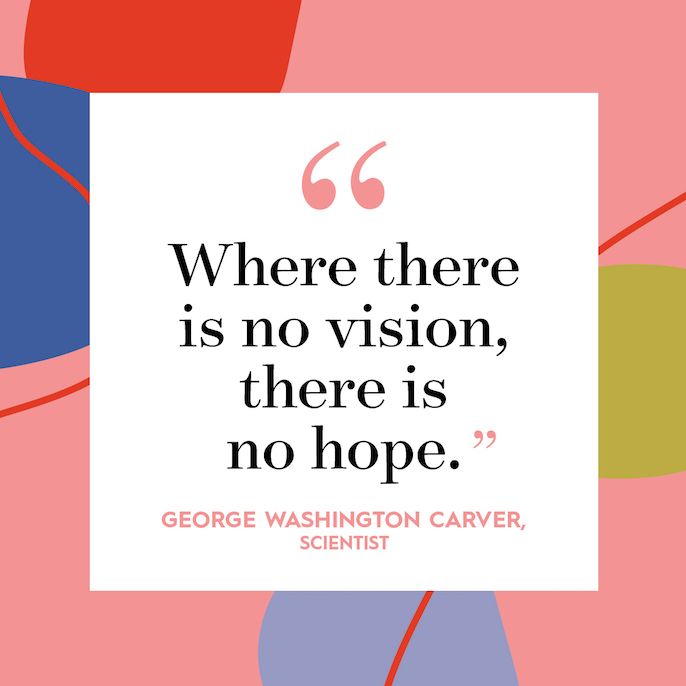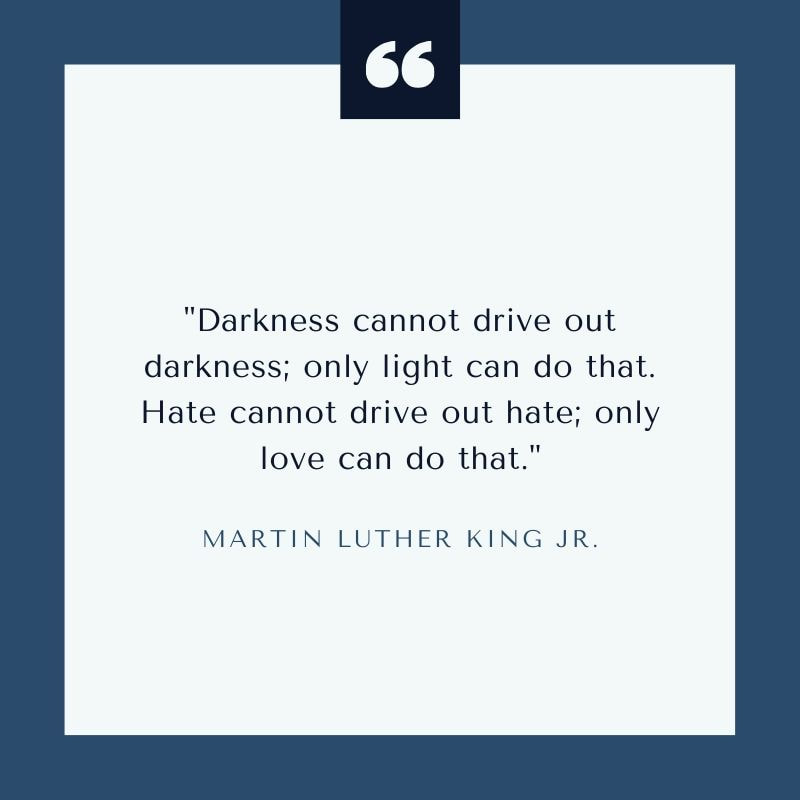Therapist Spotlight: Chase, Professional Counselor Associate

How did you decide to become a counselor?
Chase: I originally went to school to become a middle or high school teacher, but then decided that I wanted to go deeper with people and have one-on-one conversations that led to realizations and change. I also remember enjoying talking to friends and family about issues that they wouldn’t tell anyone else; it feels like a gift to be able to hold someone else’s secrets and have that responsibility and trust from them.
What do you enjoy most about your work?
Chase: What I enjoy most about my work is being able to see the relief or surprise on my client’s faces when they come to a realization about something. It is a privilege to be able to see and help facilitate a change in someone’s life that has been a long time struggle.
Anxiety is the primary focus of your work. What drew you to this niche?
Chase: What drew me to anxiety is the fascination that I have with it. I have observed and studied phobias, obsessive-compulsive disorder (OCD), general anxiety and trauma, and they all seem to have very similar characteristics and ways to treat them.
What would you tell someone considering starting therapy for the first time?
Chase: I would tell them that there is nothing that you need to do in order to be here. You are you and that is all that we need to start this journey together! There is nothing that you have to already know or have done before we start, you are welcome as you are!
When you aren't working, what do you like to do for fun or for self-care?
Chase: For fun and self-care, I enjoy weightlifting, photography, exploring rural areas in Oregon and competitive table tennis. I play regional tournaments in Oregon and Washington (It’s also an Olympic sport!).
If you could have any super power, what would it be and why?
Chase: If I could have any superpower, I would have the ability to speak any language in the world. It would make traveling so much easier and it would be nice to be able to feel more comfortable in a foreign language-speaking community.
Chase: I originally went to school to become a middle or high school teacher, but then decided that I wanted to go deeper with people and have one-on-one conversations that led to realizations and change. I also remember enjoying talking to friends and family about issues that they wouldn’t tell anyone else; it feels like a gift to be able to hold someone else’s secrets and have that responsibility and trust from them.
What do you enjoy most about your work?
Chase: What I enjoy most about my work is being able to see the relief or surprise on my client’s faces when they come to a realization about something. It is a privilege to be able to see and help facilitate a change in someone’s life that has been a long time struggle.
Anxiety is the primary focus of your work. What drew you to this niche?
Chase: What drew me to anxiety is the fascination that I have with it. I have observed and studied phobias, obsessive-compulsive disorder (OCD), general anxiety and trauma, and they all seem to have very similar characteristics and ways to treat them.
What would you tell someone considering starting therapy for the first time?
Chase: I would tell them that there is nothing that you need to do in order to be here. You are you and that is all that we need to start this journey together! There is nothing that you have to already know or have done before we start, you are welcome as you are!
When you aren't working, what do you like to do for fun or for self-care?
Chase: For fun and self-care, I enjoy weightlifting, photography, exploring rural areas in Oregon and competitive table tennis. I play regional tournaments in Oregon and Washington (It’s also an Olympic sport!).
If you could have any super power, what would it be and why?
Chase: If I could have any superpower, I would have the ability to speak any language in the world. It would make traveling so much easier and it would be nice to be able to feel more comfortable in a foreign language-speaking community.
The Path to Hope: NAMI Walk for Mental Health Awareness
On Saturday May 18th, members of the WSky team met at Island Park in Springfield and participated in the 2024 Lane County Nami Walk, an annual 5k walk for May Mental Health Awareness Month. The event raised over $30,000 for evidence-based mental health programs in Lane County.
The National Alliance on Mental Illness (NAMI) provides free peer-led support, education, and advocacy programs. The organization has chapters across the United States. NAMI Lane County is on a mission to improve the lives of individuals living with mental illness, as well as their friends and family. NAMI Connection Support Groups serves individuals with mental health conditions, and NAMI Family Support Groups provide support for for individuals who have a loved one struggling with mental health. To learn more about mental health programs offered by NAMI Lane County, visit namilane.org
The National Alliance on Mental Illness (NAMI) provides free peer-led support, education, and advocacy programs. The organization has chapters across the United States. NAMI Lane County is on a mission to improve the lives of individuals living with mental illness, as well as their friends and family. NAMI Connection Support Groups serves individuals with mental health conditions, and NAMI Family Support Groups provide support for for individuals who have a loved one struggling with mental health. To learn more about mental health programs offered by NAMI Lane County, visit namilane.org
The WSky team showed up to participate in the walk, and enjoyed connecting with the community, moving our bodies, and feeling the sunshine together.
Spring News, April 2024

Spring Forward: Tips for a Good Night's Sleep
Can you improve your mental health with your eyes closed? Poor sleep is associated with mental health issues, like depression and anxiety. Our brains need rest. When we get proper sleep, we tend to have less trouble concentrating, making decisions, coping with stress, and regulating emotions.
Many of us know the importance of sleep but still struggle to get enough. Daylight savings can make it even more challenging by throwing off our circadian rhythm. When it gets dark outside, our bodies naturally release the hormone melatonin, and we get sleepy. When the clocks spring forward, we experience more sunlight in the evening. Our routines and our body's natural cycle can get thrown off because it gets darker later, and it can be difficult to fall asleep.
Sleep problems can be frustrating. Fortunately, there are steps we can take throughout the day to help improve our sleep.
During the day...
Can you improve your mental health with your eyes closed? Poor sleep is associated with mental health issues, like depression and anxiety. Our brains need rest. When we get proper sleep, we tend to have less trouble concentrating, making decisions, coping with stress, and regulating emotions.
Many of us know the importance of sleep but still struggle to get enough. Daylight savings can make it even more challenging by throwing off our circadian rhythm. When it gets dark outside, our bodies naturally release the hormone melatonin, and we get sleepy. When the clocks spring forward, we experience more sunlight in the evening. Our routines and our body's natural cycle can get thrown off because it gets darker later, and it can be difficult to fall asleep.
Sleep problems can be frustrating. Fortunately, there are steps we can take throughout the day to help improve our sleep.
During the day...
- Exercise regularly.
- Go outside and get exposure to sunlight.
- Avoid caffeine, especially in the afternoon.
- Dim the lights an hour before bed.
- Avoid screens and blue lights an hour before bed.
- Wind-down with relaxing activities, like reading, journaling, or meditating.
- Go to bed at the same time every night.
- Create a comfortable environment with a mattress, blankets, and pillows that feel good to you.
- Block out excess light that might disturb your sleep.
Fall News, December 2023
In this Issue...
- We shine a spotlight on Morgan, CSWA
- We reflect on how we've grown over the past year,
- We learn about Hygge to cope with winter blues, and
- We ease stress and tension with Progressive Muscle Relaxation.
- We shine a spotlight on Morgan, CSWA
- We reflect on how we've grown over the past year,
- We learn about Hygge to cope with winter blues, and
- We ease stress and tension with Progressive Muscle Relaxation.

Therapist Spotlight: Morgan, CSWA
What drew you to the social work and mental health counseling profession?
Morgan: I have always been interested in understanding why people do things and how their individual experiences impact their lives. I received services and support from a social worker when I was an adolescent, and he introduced me to the different ways in which social workers helped within the foster care/child support field.
You primarily work with adults struggling with eating disorders, trauma, relationship issues, depression, and anxiety. What do you find rewarding about working with folks with these experiences?
Morgan: The most rewarding part of working with different folks is the connection and vulnerability I notice in each therapy session. Healing from trauma takes a lot of courage and strength, and I appreciate others being willing to share their lives in a space together.
What is the most important thing you have learned since becoming a therapist?
Morgan: The most important thing I have learned since becoming a therapist is self-care is so important for maintaining a work/life balance! It’s important for us as therapists and for our clients.
If someone were considering starting therapy for the first time, what would you want them to know?
Morgan: Therapy is a personal fit. I would want them to know therapy can be collaborative and supportive. I want them to know they are very courageous and vulnerable for showing up.
When you aren't working, how do you like to relax and have fun?
Morgan: I enjoy spending time with family, I love to be outside, listening to and watching live music, playing my guitar, and eating delicious food!
Can you share any fun facts about yourself?
Morgan: I am ambidextrous, I was born in Wisconsin, and I take guitar lessons for fun!
What drew you to the social work and mental health counseling profession?
Morgan: I have always been interested in understanding why people do things and how their individual experiences impact their lives. I received services and support from a social worker when I was an adolescent, and he introduced me to the different ways in which social workers helped within the foster care/child support field.
You primarily work with adults struggling with eating disorders, trauma, relationship issues, depression, and anxiety. What do you find rewarding about working with folks with these experiences?
Morgan: The most rewarding part of working with different folks is the connection and vulnerability I notice in each therapy session. Healing from trauma takes a lot of courage and strength, and I appreciate others being willing to share their lives in a space together.
What is the most important thing you have learned since becoming a therapist?
Morgan: The most important thing I have learned since becoming a therapist is self-care is so important for maintaining a work/life balance! It’s important for us as therapists and for our clients.
If someone were considering starting therapy for the first time, what would you want them to know?
Morgan: Therapy is a personal fit. I would want them to know therapy can be collaborative and supportive. I want them to know they are very courageous and vulnerable for showing up.
When you aren't working, how do you like to relax and have fun?
Morgan: I enjoy spending time with family, I love to be outside, listening to and watching live music, playing my guitar, and eating delicious food!
Can you share any fun facts about yourself?
Morgan: I am ambidextrous, I was born in Wisconsin, and I take guitar lessons for fun!
Taking Time for Self-Reflection at the End of the Year
2023 is coming to an end. Before turning our attention to what we hope for in the new year, it can be helpful to spend some time reviewing the past 12 months. Reflecting back on the past year, you might think of events that have happened, time spent with people you care about, challenges you have faced, and ways that you have grown. Taking this time to reflect can help you identify your resolutions, goals, and hopes for 2024.
Use the questions below to help guide your thoughts. You can write in a journal, talk with a friend, or simply ponder in your mind. You don’t have to answer every question. You can choose the ones that feel relevant or helpful to you.
Life's Joys - Big & Small
- What made you laugh this year?
- What are your favorite books, music, or movies this year?
- What are you most grateful for this year?
Relationships
- Who do you need to thank for their role in your life this year?
- When was a time you asked for help this year and were glad you did?
- What is the best compliment you have received this year?
Life Satisfaction
- How would you summarize this year in a sentence?
- How satisfied are you with your life this year?
- What aspects of your life have improved this year?
Personal Growth
- What are the biggest lessons you’ve learned this year? How will you apply these lessons next year?
- What qualities do you like about the person you are this year?
- What are the biggest challenges you’ve faced this year? How did you overcome them? What did you realize after overcoming these challenges?
Goals
- What did you try that didn't work out, but the process of trying it moved your thinking forward in a helpful way?
- What was a goal for the year that you followed through on? How does it feel to have worked toward this goal?
2023 is coming to an end. Before turning our attention to what we hope for in the new year, it can be helpful to spend some time reviewing the past 12 months. Reflecting back on the past year, you might think of events that have happened, time spent with people you care about, challenges you have faced, and ways that you have grown. Taking this time to reflect can help you identify your resolutions, goals, and hopes for 2024.
Use the questions below to help guide your thoughts. You can write in a journal, talk with a friend, or simply ponder in your mind. You don’t have to answer every question. You can choose the ones that feel relevant or helpful to you.
Life's Joys - Big & Small
- What made you laugh this year?
- What are your favorite books, music, or movies this year?
- What are you most grateful for this year?
Relationships
- Who do you need to thank for their role in your life this year?
- When was a time you asked for help this year and were glad you did?
- What is the best compliment you have received this year?
Life Satisfaction
- How would you summarize this year in a sentence?
- How satisfied are you with your life this year?
- What aspects of your life have improved this year?
Personal Growth
- What are the biggest lessons you’ve learned this year? How will you apply these lessons next year?
- What qualities do you like about the person you are this year?
- What are the biggest challenges you’ve faced this year? How did you overcome them? What did you realize after overcoming these challenges?
Goals
- What did you try that didn't work out, but the process of trying it moved your thinking forward in a helpful way?
- What was a goal for the year that you followed through on? How does it feel to have worked toward this goal?

Hygge: How Coziness can Help us Cope with the Winter Blues
When the holidays roll in, so do numerous other seasonal changes: the weather gets colder, days become shorter. These changes can take a toll on our mental wellbeing. As challenging as seasonal depression can be, there are certain ways to fend off the winter blues. The Danish concept of "Hygge" (pronounced "hue-gah"), translating roughly to "coziness", conceptualizes a key characteristic of Danish culture: making time to keep oneself cozy and comfy, taking care to appreciate life's small joys amidst cold climates or hectic schedules.
The phrase “hygge” originates in old Norwegian, eventually surfacing in Danish culture sometime around the end of the 18th century. While the concept of hygge is applied and practiced in Danish culture on a year-round basis, the winter seasons are known as the “high point” of partaking in hygge. Due to notoriously long and dark Danish winters, carving out a properly comforting and cozy atmosphere becomes a key aspect of keeping spirits high during the holiday seasons. Candles, mulled wine, and festive celebrations are all part of a traditionally Danish celebration of the holidays with hygge, creating a communitywide sense of camaraderie, coziness, and warmth.
Despite the difference in time zone and climate, Oregon winters can bring a similar gloomy chill as days get shorter, darker, and colder. These changes can bring about or exacerbate symptoms of depression or Seasonal Affective Disorder (SAD). Understanding when and how seasonal shifts impact our mental health can help us plan ways to cope and take care of ourselves.
When facing the current rainy season in Oregon, there are numerous ways to help lessen the effects of these changes. Practicing hygge can be as simple as taking the time to light candles, preparing a warm drink while starting your day, wearing your comfiest clothes, or sharing a meal with people you love. While shopping needn’t be a part of celebrating hygge, the local Eugene Holiday Market reliably embodies the community-based holiday sense of comfort, providing a warm, cozy marketplace for the Eugene community to come together, enjoy free performances and music, and support local artisans and creators. Whatever specific practices work for you, finding ways to carve comfort out of the colder seasons and connect oneself to the larger community can help alleviate the holiday blues.
When the holidays roll in, so do numerous other seasonal changes: the weather gets colder, days become shorter. These changes can take a toll on our mental wellbeing. As challenging as seasonal depression can be, there are certain ways to fend off the winter blues. The Danish concept of "Hygge" (pronounced "hue-gah"), translating roughly to "coziness", conceptualizes a key characteristic of Danish culture: making time to keep oneself cozy and comfy, taking care to appreciate life's small joys amidst cold climates or hectic schedules.
The phrase “hygge” originates in old Norwegian, eventually surfacing in Danish culture sometime around the end of the 18th century. While the concept of hygge is applied and practiced in Danish culture on a year-round basis, the winter seasons are known as the “high point” of partaking in hygge. Due to notoriously long and dark Danish winters, carving out a properly comforting and cozy atmosphere becomes a key aspect of keeping spirits high during the holiday seasons. Candles, mulled wine, and festive celebrations are all part of a traditionally Danish celebration of the holidays with hygge, creating a communitywide sense of camaraderie, coziness, and warmth.
Despite the difference in time zone and climate, Oregon winters can bring a similar gloomy chill as days get shorter, darker, and colder. These changes can bring about or exacerbate symptoms of depression or Seasonal Affective Disorder (SAD). Understanding when and how seasonal shifts impact our mental health can help us plan ways to cope and take care of ourselves.
When facing the current rainy season in Oregon, there are numerous ways to help lessen the effects of these changes. Practicing hygge can be as simple as taking the time to light candles, preparing a warm drink while starting your day, wearing your comfiest clothes, or sharing a meal with people you love. While shopping needn’t be a part of celebrating hygge, the local Eugene Holiday Market reliably embodies the community-based holiday sense of comfort, providing a warm, cozy marketplace for the Eugene community to come together, enjoy free performances and music, and support local artisans and creators. Whatever specific practices work for you, finding ways to carve comfort out of the colder seasons and connect oneself to the larger community can help alleviate the holiday blues.

Progressive Muscle Relaxation
Our mental and physical wellbeing impact one another, and feelings of stress can manifest as tension in our bodies. By teaching us to recognize feelings of muscle tension, Progressive Muscle Relaxation exercises can help us identify when we're feeling stressed or anxious and in need of extra self-care.
Sit in a comfortable position and follow the steps below. Hold each position for 15 to 30 seconds. Notice how you feel in each area of your body, and enjoy as stress and tension melt away.
Feet: Curl your toes tightly into your feet, then release them.
Calves: Point or flex your feet, then let them relax.
Thighs: Squeeze your thighs together tightly, then let them relax.
Torso: Suck in your abdomen, then release the tension and let it fall.
Back: Squeeze your shoulder blades back together, then release them.
Shoulders: Lift and squeeze your shoulders toward your ears, then let them drop.
Arms: Make fists and squeeze them toward your shoulders, then let them drop.
Hands: Make a fist by curling your fingers into your palm, then relax your fingers.
Face: Scrunch your facial features to the center of your face, then relax.
Full Body: Squeeze all muscles together, then release all tension.
Our mental and physical wellbeing impact one another, and feelings of stress can manifest as tension in our bodies. By teaching us to recognize feelings of muscle tension, Progressive Muscle Relaxation exercises can help us identify when we're feeling stressed or anxious and in need of extra self-care.
Sit in a comfortable position and follow the steps below. Hold each position for 15 to 30 seconds. Notice how you feel in each area of your body, and enjoy as stress and tension melt away.
Feet: Curl your toes tightly into your feet, then release them.
Calves: Point or flex your feet, then let them relax.
Thighs: Squeeze your thighs together tightly, then let them relax.
Torso: Suck in your abdomen, then release the tension and let it fall.
Back: Squeeze your shoulder blades back together, then release them.
Shoulders: Lift and squeeze your shoulders toward your ears, then let them drop.
Arms: Make fists and squeeze them toward your shoulders, then let them drop.
Hands: Make a fist by curling your fingers into your palm, then relax your fingers.
Face: Scrunch your facial features to the center of your face, then relax.
Full Body: Squeeze all muscles together, then release all tension.
Summer News, August 2023
In this Issue...
- We shine a spotlight on Hadass, MFT-A,
- We get to know Bri, MFT-A,
- We develop a growth mindset
- We explore the value of social connection, and
- We create calm with the Mammalian Diving Reflex.
- We shine a spotlight on Hadass, MFT-A,
- We get to know Bri, MFT-A,
- We develop a growth mindset
- We explore the value of social connection, and
- We create calm with the Mammalian Diving Reflex.

Therapist Spotlight: Hadass, MFT-A
How did you decide to become a therapist?
Hadass: I remember when I was 13 years old I was thinking about my future and just knew I wanted to help others. My path started with offering life coaching, and I was immediately entranced by how amazing it was to help others set goals they had for themselves and watch as their life changed when they accomplished what they had set out to do.
Over time, I also felt the need to help others do deeper healing work to integrate their past so that their life became a space of greater ease, self-acceptance, and possibility moving forward. I saw that therapy offered others the ability to let go of past hurts, have greater self-love, and more fulfilling relationships, and wanted to help others in having a life that encompassed all of these things.
What is the best thing about your work?
Hadass: It is incredibly rewarding to watch clients go on a journey towards greater wellness. When someone is struggling with anxiety, depression, or past trauma It can take over much of their life. As they begin to process and release the hurt of their past and have greater self-care, they find themselves more at ease and happier in their life and find that they feel strong yet again. I am honored to be part of that process. I also genuinely enjoy helping couples discover how to resolve conflict and strengthen intimacy and trust between them. It is wonderful to watch them get closer and more loving towards one another as a result.
How would you describe your therapy practice?
Hadass: It is important to me that this process feels empowering and collaborative for the clients I work with. Every client has their own pace and their own needs, and it is important they feel safe and seen, especially as they make space for their emotions and needs in their life. This also includes creating a culturally safe space for others to integrate all parts of themselves and life. As we work together, we explore individual strengths and goals which help set the foundation for each client to be be the person they want to be in their life.
What is one thing you'd want someone considering starting therapy to know?
Hadass: Therapy is a great resource to support you! While it can feel a little unknown at first, this is a place where you get to discover your strengths and gain tools to have more of what you want in life. It’s ok to go at your own pace and talk about what does and doesn’t work for you. Sometimes therapy can also feel challenging, but you will always be supported in the therapy room. Other times it will also be a great place to celebrate life wins and acknowledge the good work you are doing.
What brings you joy outside of work?
Hadass: So many things bring me joy! I love being on water year-round – hot springs in the winter, paddleboarding and swimming in the summer. Also all sorts of expressive dance and dressing up is such a fun way to play and connect with the world.
How did you decide to become a therapist?
Hadass: I remember when I was 13 years old I was thinking about my future and just knew I wanted to help others. My path started with offering life coaching, and I was immediately entranced by how amazing it was to help others set goals they had for themselves and watch as their life changed when they accomplished what they had set out to do.
Over time, I also felt the need to help others do deeper healing work to integrate their past so that their life became a space of greater ease, self-acceptance, and possibility moving forward. I saw that therapy offered others the ability to let go of past hurts, have greater self-love, and more fulfilling relationships, and wanted to help others in having a life that encompassed all of these things.
What is the best thing about your work?
Hadass: It is incredibly rewarding to watch clients go on a journey towards greater wellness. When someone is struggling with anxiety, depression, or past trauma It can take over much of their life. As they begin to process and release the hurt of their past and have greater self-care, they find themselves more at ease and happier in their life and find that they feel strong yet again. I am honored to be part of that process. I also genuinely enjoy helping couples discover how to resolve conflict and strengthen intimacy and trust between them. It is wonderful to watch them get closer and more loving towards one another as a result.
How would you describe your therapy practice?
Hadass: It is important to me that this process feels empowering and collaborative for the clients I work with. Every client has their own pace and their own needs, and it is important they feel safe and seen, especially as they make space for their emotions and needs in their life. This also includes creating a culturally safe space for others to integrate all parts of themselves and life. As we work together, we explore individual strengths and goals which help set the foundation for each client to be be the person they want to be in their life.
What is one thing you'd want someone considering starting therapy to know?
Hadass: Therapy is a great resource to support you! While it can feel a little unknown at first, this is a place where you get to discover your strengths and gain tools to have more of what you want in life. It’s ok to go at your own pace and talk about what does and doesn’t work for you. Sometimes therapy can also feel challenging, but you will always be supported in the therapy room. Other times it will also be a great place to celebrate life wins and acknowledge the good work you are doing.
What brings you joy outside of work?
Hadass: So many things bring me joy! I love being on water year-round – hot springs in the winter, paddleboarding and swimming in the summer. Also all sorts of expressive dance and dressing up is such a fun way to play and connect with the world.

Therapist Spotlight: Bri, MFT-A
What drew you to this profession?
Bri: I strongly believe that no one should have to feel alone when they are struggling and overwhelmed. My own experiences with an extraordinary therapist who helped me in processing my trauma led me to an interest in doing therapy.
What do you enjoy most about being a therapist?
Bri: It’s so fulfilling to support people in taking control of their own stories and lives - watching clients gain confidence in using tools, describing their emotions, and working through their past is endlessly rewarding. I really enjoy watching couples, families, and intimate partners open up to each other and feel fully understood, seen, and embraced by their loved ones.
How would you describe your approach to working with clients?
Bri: Critical to my practice is the knowledge that, except in extraordinary circumstances, no one is more of an expert on your life than you are. I believe that all situations, actions, and emotions make sense when we can see the full picture. Once we have a goal in mind, I try to walk alongside clients at their own pace and support them in examining what works for them and what doesn't in support of those goals.
What is one thing you'd like someone considering therapy to know?
Bri: You deserve to have the space and time to heal and express your emotions. You deserve to feel happy, healthy, and safe in your relationships. Therapy is for whatever you need to work on - whether it's trauma, anxiety, grief, depression, or just feeling stuck. There is no issue that is too big or small for us to talk about in session. Also, there's no rush - we want to go at your pace, make sure that you feel as in control as possible, and be fully oriented toward whatever goals you bring in. If it doesn't feel right, let us know and we'll adjust. The most important thing for me is that you feel therapy is beneficial and that it’s working for you.
When you aren't working, how do you enjoy spending your free time?
Bri: I like to read (mostly sci-fi, history, and fantasy), hang out with my partner, write, play video games, and eat good (usually spicy) food. I also really like to study languages!
What drew you to this profession?
Bri: I strongly believe that no one should have to feel alone when they are struggling and overwhelmed. My own experiences with an extraordinary therapist who helped me in processing my trauma led me to an interest in doing therapy.
What do you enjoy most about being a therapist?
Bri: It’s so fulfilling to support people in taking control of their own stories and lives - watching clients gain confidence in using tools, describing their emotions, and working through their past is endlessly rewarding. I really enjoy watching couples, families, and intimate partners open up to each other and feel fully understood, seen, and embraced by their loved ones.
How would you describe your approach to working with clients?
Bri: Critical to my practice is the knowledge that, except in extraordinary circumstances, no one is more of an expert on your life than you are. I believe that all situations, actions, and emotions make sense when we can see the full picture. Once we have a goal in mind, I try to walk alongside clients at their own pace and support them in examining what works for them and what doesn't in support of those goals.
What is one thing you'd like someone considering therapy to know?
Bri: You deserve to have the space and time to heal and express your emotions. You deserve to feel happy, healthy, and safe in your relationships. Therapy is for whatever you need to work on - whether it's trauma, anxiety, grief, depression, or just feeling stuck. There is no issue that is too big or small for us to talk about in session. Also, there's no rush - we want to go at your pace, make sure that you feel as in control as possible, and be fully oriented toward whatever goals you bring in. If it doesn't feel right, let us know and we'll adjust. The most important thing for me is that you feel therapy is beneficial and that it’s working for you.
When you aren't working, how do you enjoy spending your free time?
Bri: I like to read (mostly sci-fi, history, and fantasy), hang out with my partner, write, play video games, and eat good (usually spicy) food. I also really like to study languages!

How to Develop a Growth Mindset
How do you face challenges and setbacks? A “fixed mindset” refers to a belief that no amount of hard work can improve an individual's skills, and talents are innate gifts. In contrast, a “growth mindset” refers to the perspective that a person's skills and abilities are not set in stone and can be improved. From this point of view, talents are developed through hard work and persistence.
Reflect on challenges you have faced and how you've responded to past setbacks. Do you have more of a fixed or growth mindset? In truth, everyone has a mix of the two, but we can always strengthen our growth mindset.
Challenges are opportunities for growth. In school, work, and daily life, challenges are inevitable, so how we approach those difficulties is key. Our mindset helps determine our outcome. When we face adversity, we can try to reframe a problem to be fixed as a challenge to be accomplished instead. If we expect the unexpected and anticipate roadblocks, we can give ourselves permission to try and to fail. Setbacks are not a sign of failure. They are part of the growth process.
Tips to strengthen your growth mindset:
How do you face challenges and setbacks? A “fixed mindset” refers to a belief that no amount of hard work can improve an individual's skills, and talents are innate gifts. In contrast, a “growth mindset” refers to the perspective that a person's skills and abilities are not set in stone and can be improved. From this point of view, talents are developed through hard work and persistence.
Reflect on challenges you have faced and how you've responded to past setbacks. Do you have more of a fixed or growth mindset? In truth, everyone has a mix of the two, but we can always strengthen our growth mindset.
Challenges are opportunities for growth. In school, work, and daily life, challenges are inevitable, so how we approach those difficulties is key. Our mindset helps determine our outcome. When we face adversity, we can try to reframe a problem to be fixed as a challenge to be accomplished instead. If we expect the unexpected and anticipate roadblocks, we can give ourselves permission to try and to fail. Setbacks are not a sign of failure. They are part of the growth process.
Tips to strengthen your growth mindset:
- Practice gratitude: By turning our attention to what we have, we focus less on what we lack. Practicing gratitude can help us feel more optimistic and have a more positive overall outlook.
- Replace judgment with acceptance: Pay attention to your words and practice replacing negative thoughts with more positive ones. Speak kindly to yourself.
- Focus on self acceptance: Accept that no one is perfect, and we are all constantly learning and growing.
- Remember that the purpose of criticism is to make things better: Ask for feedback and support from people you trust. From feedback, we learn where our weaknesses are and what to focus on moving forward.
- Persist in the face of setbacks: Know that you will face setbacks along your journey and prepare yourself to keep going when it gets difficult.
- Remember that practice makes perfect: “Not yet” is ok!

The Value of Social Connection
According to the US Surgeon General, one-in-two Americans report experiencing loneliness. Unfortunately, chronic social disconnection can have serious negative consequences. The Surgeon General reports that loneliness and isolation increase the risk of diseases, like cardiovascular disease (CVD), dementia, and depression, and lowers mortality. Although this might sound alarming, the good news is that social connection is a “source of healing hiding in plain sight”.
Many people are lonely because they struggle in making social connections. Fortunately, there are simple actions you can incorporate into your day-to-day life to build connections. Express gratitude to your bank teller. Smile at your grocery store clerk. Say hello to your neighbors. Text an old friend to let them know you're thinking of them. If you're feeling daring, invite a colleague to coffee. Look for opportunities in your day to add small positive interactions like these. They can make a big difference in how you feel!
When you're ready to make a bigger step towards building social connections, try committing to a shared interest. Join a drawing class, yoga studio, book club, softball team, or community garden. Look online for local meetups or clubs. Once you find something you like, hold yourself accountable and engage consistently. It's easy to prioritize other things or stay at home on the couch, but a commitment to showing up reflects that you value and prioritize social connection.
Also remember that if you are feeling lonely, you are not the only one, and you are not alone. Seek help when you are struggling. Reach out to your therapist, family, and friends, and share how you're feeling with people you trust.
According to the US Surgeon General, one-in-two Americans report experiencing loneliness. Unfortunately, chronic social disconnection can have serious negative consequences. The Surgeon General reports that loneliness and isolation increase the risk of diseases, like cardiovascular disease (CVD), dementia, and depression, and lowers mortality. Although this might sound alarming, the good news is that social connection is a “source of healing hiding in plain sight”.
Many people are lonely because they struggle in making social connections. Fortunately, there are simple actions you can incorporate into your day-to-day life to build connections. Express gratitude to your bank teller. Smile at your grocery store clerk. Say hello to your neighbors. Text an old friend to let them know you're thinking of them. If you're feeling daring, invite a colleague to coffee. Look for opportunities in your day to add small positive interactions like these. They can make a big difference in how you feel!
When you're ready to make a bigger step towards building social connections, try committing to a shared interest. Join a drawing class, yoga studio, book club, softball team, or community garden. Look online for local meetups or clubs. Once you find something you like, hold yourself accountable and engage consistently. It's easy to prioritize other things or stay at home on the couch, but a commitment to showing up reflects that you value and prioritize social connection.
Also remember that if you are feeling lonely, you are not the only one, and you are not alone. Seek help when you are struggling. Reach out to your therapist, family, and friends, and share how you're feeling with people you trust.

Relax and Create Calm with the Mammalian Diving Reflex
The Mammalian Diving Reflex is a physiological response present in most mammals, including humans, to conserve energy and oxygen while underwater. When mammals hold their breath and immerse their face in cold water, the nervous system triggers its relaxation response. We can purposefully activate the Diving Reflex to help us relax and regulate our emotions.
Can you remember a time when your emotions were so overwhelming that it was difficult to calm down, think clearly, or address what was upsetting you? When we are in a state of high emotional arousal, experiencing cold water on our face can help us relax and return to a more functional state of mind. Once we quell extreme emotions, we are more capable of processing incoming information, using problem solving skills, practicing other emotion regulation and distress tolerance skills, and approaching difficult situations with a clearer, calmer mind.
This simple Dialectical Behavioral Therapy (DBT) skill can help you quickly calm down from intense emotions.
Calm extreme emotions in 30 seconds: Fill a bowl with icy cold water. Hold your breath, and put your face in the water for 30 seconds. Make sure the water covers the area under your eyes and above your cheekbones, which is the most sensitive area on the face. (Alternatively, you can splash cold water on your face or use a cold gel eye mask or wet washcloth.) Once you're done, check-in with how you are feeling - hopefully, a little more relaxed!
*Because the Mammalian Diving Reflex slows the heart rate, anyone with heart problems, who has an eating disorder, or who is pregnant should talk to a healthcare provider first.
The Mammalian Diving Reflex is a physiological response present in most mammals, including humans, to conserve energy and oxygen while underwater. When mammals hold their breath and immerse their face in cold water, the nervous system triggers its relaxation response. We can purposefully activate the Diving Reflex to help us relax and regulate our emotions.
Can you remember a time when your emotions were so overwhelming that it was difficult to calm down, think clearly, or address what was upsetting you? When we are in a state of high emotional arousal, experiencing cold water on our face can help us relax and return to a more functional state of mind. Once we quell extreme emotions, we are more capable of processing incoming information, using problem solving skills, practicing other emotion regulation and distress tolerance skills, and approaching difficult situations with a clearer, calmer mind.
This simple Dialectical Behavioral Therapy (DBT) skill can help you quickly calm down from intense emotions.
Calm extreme emotions in 30 seconds: Fill a bowl with icy cold water. Hold your breath, and put your face in the water for 30 seconds. Make sure the water covers the area under your eyes and above your cheekbones, which is the most sensitive area on the face. (Alternatively, you can splash cold water on your face or use a cold gel eye mask or wet washcloth.) Once you're done, check-in with how you are feeling - hopefully, a little more relaxed!
*Because the Mammalian Diving Reflex slows the heart rate, anyone with heart problems, who has an eating disorder, or who is pregnant should talk to a healthcare provider first.
Spring News, May 2023
In this Issue...
- We shine a spotlight on Kimberly, MFT-A,
- We learn about spring-time Seasonal Affective Disorder (SAD), and
- We find time in our schedules for self-care!
- We shine a spotlight on Kimberly, MFT-A,
- We learn about spring-time Seasonal Affective Disorder (SAD), and
- We find time in our schedules for self-care!

Therapist Spotlight: Kimberly, MFT-A
What do you enjoy most about your work?
Kimberly: I love being able to meet and connect with new people, and support clients in the goals they want to reach for themselves. I work from a strengths-based lens, so I feel both honored and fulfilled being able to support clients in identifying and utilizing the strengths they already inherently possess. This work is rewarding with being able to have clients trust you in sharing their lives with you!
Other than your professional training, what else in your background helped you prepare for your work as a therapist?
Kimberly: I think my roles as both a case manager and self-sufficiency worker really helped me connect with a wide variety of diverse individuals and families. It allowed me to connect with members of my community and work to support them in different aspects of their lives, whether financially, academically, socially, etc. It also reaffirmed my love for meeting and connecting with new people on a daily basis!
How would you describe your approach to working with clients?
Kimberly: I would describe my style as a combined approach, that I work to tailor each client’s individual needs. I am professionally trained from both a Systemic lens and strengths-based approach. This means I take into consideration all aspects of a client’s life and context in order to understand how these different pieces hold influence into their current lives and presenting concerns.
What is the focus of your work?
Kimberly: Being trained in a Marriage and Family Therapy program allows me to work with a wide variety of clients! I love working with individuals, couples, and family systems. This allows me to work with many diverse groups of clients, both individually and relationally, which is the focus of my work. I like to support clients by collaborating with all important members of their system and life!
Is there anything about your life outside of being a therapist that might surprise people?
Kimberly: I am a HUGE sports fan! I love both watching and playing a handful of different sports including basketball, softball, volleyball and football! Go Ducks!
What is one thing you would want someone considering therapy to know?
Kimberly: I would want them to know that I understand therapy can be a vulnerable and nervous thing to start! I would also want them to know it can also be a really rewarding and positive experience that can allow for growth and self-exploration. Anybody seeking out or considering therapy will hopefully be met with a therapist who is equally excited and supportive in reaching their goals. This is a safe space designed to be most supportive of what direction and where the client would like to go for themselves. They have the most important voice in this process!
What do you enjoy most about your work?
Kimberly: I love being able to meet and connect with new people, and support clients in the goals they want to reach for themselves. I work from a strengths-based lens, so I feel both honored and fulfilled being able to support clients in identifying and utilizing the strengths they already inherently possess. This work is rewarding with being able to have clients trust you in sharing their lives with you!
Other than your professional training, what else in your background helped you prepare for your work as a therapist?
Kimberly: I think my roles as both a case manager and self-sufficiency worker really helped me connect with a wide variety of diverse individuals and families. It allowed me to connect with members of my community and work to support them in different aspects of their lives, whether financially, academically, socially, etc. It also reaffirmed my love for meeting and connecting with new people on a daily basis!
How would you describe your approach to working with clients?
Kimberly: I would describe my style as a combined approach, that I work to tailor each client’s individual needs. I am professionally trained from both a Systemic lens and strengths-based approach. This means I take into consideration all aspects of a client’s life and context in order to understand how these different pieces hold influence into their current lives and presenting concerns.
What is the focus of your work?
Kimberly: Being trained in a Marriage and Family Therapy program allows me to work with a wide variety of clients! I love working with individuals, couples, and family systems. This allows me to work with many diverse groups of clients, both individually and relationally, which is the focus of my work. I like to support clients by collaborating with all important members of their system and life!
Is there anything about your life outside of being a therapist that might surprise people?
Kimberly: I am a HUGE sports fan! I love both watching and playing a handful of different sports including basketball, softball, volleyball and football! Go Ducks!
What is one thing you would want someone considering therapy to know?
Kimberly: I would want them to know that I understand therapy can be a vulnerable and nervous thing to start! I would also want them to know it can also be a really rewarding and positive experience that can allow for growth and self-exploration. Anybody seeking out or considering therapy will hopefully be met with a therapist who is equally excited and supportive in reaching their goals. This is a safe space designed to be most supportive of what direction and where the client would like to go for themselves. They have the most important voice in this process!

Spring-Time Seasonal Affective Disorder
Seasonal Affective Disorder (SAD) is a type of depression that occurs at certain times of the year and is triggered by the change of season. Although everyone experiences SAD differently, common symptoms can include low mood, feelings of hopelessness, change in appetite, loss of interest in activities, difficulty sleeping, agitation or irritability, and brain fog. SAD is often associated with winter, but seasonal depression can occur at any time of year. In fact, spring can be a particularly challenging time for many people.
As we transition from winter to spring, daylight saving time and increased sunlight can impact our circadian rhythm, hormones, energy, and mood. Exposure to sunlight cues your body to produce less melatonin, which helps us sleep. Sleep hygiene can have a significant impact on our mental and physical wellbeing, and difficulty sleeping can exacerbate feelings like sadness and irritability. Sunlight also affects our body’s level of serotonin. Too much or too little serotonin can negatively affect our mental health.
As the days get longer and sunnier, our routines often change accordingly. Although spring might be a welcome change after a long winter, even positive change can be difficult to navigate. Disruption to our normal schedules can make us feel out-of-sorts and anxious, and creating new routines can take time.
When winter ends, we may feel pressure to be happier and more social during the spring. Because of those social pressures, we might have high expectations for the change of season and feel disappointed if our mood doesn’t improve as much as we hoped. When we see others spending more time outdoors and enjoying the sunshine, we might feel bad if we don’t have the same level of energy or motivation.
Additionally, people can experience the same weather differently. While some folks prefer the warmer months, experiencing high temperatures can also be uncomfortable and cause feelings like agitation, restlessness, and irritability. Additionally, allergies are common during the spring, and many people experience unpleasant allergy symptoms that can contribute to a low mood and make it difficult to enjoy being outside.
If you struggle with SAD or find Spring to be a challenging time of year, you are not alone.
Seasonal Affective Disorder (SAD) is a type of depression that occurs at certain times of the year and is triggered by the change of season. Although everyone experiences SAD differently, common symptoms can include low mood, feelings of hopelessness, change in appetite, loss of interest in activities, difficulty sleeping, agitation or irritability, and brain fog. SAD is often associated with winter, but seasonal depression can occur at any time of year. In fact, spring can be a particularly challenging time for many people.
As we transition from winter to spring, daylight saving time and increased sunlight can impact our circadian rhythm, hormones, energy, and mood. Exposure to sunlight cues your body to produce less melatonin, which helps us sleep. Sleep hygiene can have a significant impact on our mental and physical wellbeing, and difficulty sleeping can exacerbate feelings like sadness and irritability. Sunlight also affects our body’s level of serotonin. Too much or too little serotonin can negatively affect our mental health.
As the days get longer and sunnier, our routines often change accordingly. Although spring might be a welcome change after a long winter, even positive change can be difficult to navigate. Disruption to our normal schedules can make us feel out-of-sorts and anxious, and creating new routines can take time.
When winter ends, we may feel pressure to be happier and more social during the spring. Because of those social pressures, we might have high expectations for the change of season and feel disappointed if our mood doesn’t improve as much as we hoped. When we see others spending more time outdoors and enjoying the sunshine, we might feel bad if we don’t have the same level of energy or motivation.
Additionally, people can experience the same weather differently. While some folks prefer the warmer months, experiencing high temperatures can also be uncomfortable and cause feelings like agitation, restlessness, and irritability. Additionally, allergies are common during the spring, and many people experience unpleasant allergy symptoms that can contribute to a low mood and make it difficult to enjoy being outside.
If you struggle with SAD or find Spring to be a challenging time of year, you are not alone.

Spring Into Self-Care
Self-care describes any behaviors or activities you choose to stay mentally, emotionally, and physically well. Self-care isn’t one-size-fits-all and can differ person to person. It can also differ day-to-day, and depending on what we need, self-care can be relaxing, intellectually or spiritually stimulating, or productive. Practicing self-care requires us to check-in with ourselves and assess how we are and what we need.
However, finding time in our schedules for self-care can feel challenging. Even if we know it’s important to make time for ourselves, it’s easy to get caught up in the busyness of our lives and forget to check in with ourselves. Do you think you’ve been making enough time for yourself lately? Why or why not?
If not, here are some suggestions for self-care activities that can fit into any schedule:
Whether you have 5 minutes or an hour, journaling can also be a great way to self-reflect. If you need help getting started, here are some questions to ask yourself:
Self-care describes any behaviors or activities you choose to stay mentally, emotionally, and physically well. Self-care isn’t one-size-fits-all and can differ person to person. It can also differ day-to-day, and depending on what we need, self-care can be relaxing, intellectually or spiritually stimulating, or productive. Practicing self-care requires us to check-in with ourselves and assess how we are and what we need.
However, finding time in our schedules for self-care can feel challenging. Even if we know it’s important to make time for ourselves, it’s easy to get caught up in the busyness of our lives and forget to check in with ourselves. Do you think you’ve been making enough time for yourself lately? Why or why not?
If not, here are some suggestions for self-care activities that can fit into any schedule:
- 5-15 Minutes: Follow a guided meditation; make your favorite drink, meal, or snack; take a hot or cold shower; get a change of scenery; listen to your favorite song or playlist; dance or stretch
- 1-2 Hours: Go for a walk or hike outside; get a manicure, haircut, or massage; attend a concert or event; volunteer your time; connect with a friend; go to therapy
- 1 Day: take a work-free day (including unpaid work); take a trip to the coast or experience nature; create boundaries with technology and have a screen-free day; engage in your favorite hobbies with your friends (i.e., make music together, play tennis, cook a meal, etc.)
Whether you have 5 minutes or an hour, journaling can also be a great way to self-reflect. If you need help getting started, here are some questions to ask yourself:
- What kind of spring self-care will you prioritize this season?
- If you could cultivate the garden of your dreams, what would be in it?
- Describe the emotions that rainy vs. sunny days evoke for you.
- What is one positive affirmation you really want to hold onto this season?
- What are you grateful for each day? Take time at the end of the day write down 3 things you are grateful for and 1 quality you appreciate about yourself.
Winter News, December 2022
In this Issue...
- We shine a spotlight on Maddy, PC-A.
- We learn about being new to therapy
- We talk about the holiday blues.
- We read about the power of forgiveness.
- We shine a spotlight on Maddy, PC-A.
- We learn about being new to therapy
- We talk about the holiday blues.
- We read about the power of forgiveness.

Therapist Spotlight: Maddy, PC-A
How did you decide to become a therapist?
Maddy: I had an amazing therapist when I was a teen, which sparked my interest in therapy. I knew I wanted to help people and be a safe space for them. Growing up I was the friend that people came to for support, and once I took psychology classes in college, I knew it was the right path for me.
What else in your background helped you prepare for the job you have now?
Maddy: Something that has been helpful for becoming a therapist was my experience working in retail. I learned very quickly that everyone just wants to be heard and validated. Working in retail, I realized that a lot of people don’t have someone to talk to and that they need that support in their day-to-day lives.
What is the focus of your work these days?
Maddy: My focus has shifted over time, but I really enjoy working with teens and young adults. It feels really satisfying to work with people who are just starting to figure out their path in life. I work with all ages, but 14-24 is my favorite. I also focus on eating disorders, which often overlaps with young adults by nature. I know from experience how helpful it is to have a therapist who understands a diagnosis because they themselves have worked through it.
What do you enjoy most about being a therapist?
Maddy: I love connecting with people and being a safe space for them to share their hardest moments with. It is so rewarding witnessing people make changes in their lives and have new experiences. People will come to sessions so proud of themselves for doing something challenging or difficult that they did not think they could do. Watching people conquer their issues and seeing what they are capable of is beautiful.
What about your life outside of being a therapist might surprise people?
Maddy: I really enjoy DIY home projects and decorating. Since moving to Eugene, I have enjoyed making my apartment my safe space and that has included a lot of DIY projects. I got into these kinds of projects during the beginning of quarantine and have stuck with it since.
What's one thing you'd want someone considering therapy to know?
Maddy: That it is ok to be nervous to start therapy. Trusting a therapist you just met can be nerve wracking, but you can do it. Therapy is such a help to decompress your week or talk about your trauma. Finding the right therapist, someone you connect with, can make all of the difference in how your therapy experience goes.
How did you decide to become a therapist?
Maddy: I had an amazing therapist when I was a teen, which sparked my interest in therapy. I knew I wanted to help people and be a safe space for them. Growing up I was the friend that people came to for support, and once I took psychology classes in college, I knew it was the right path for me.
What else in your background helped you prepare for the job you have now?
Maddy: Something that has been helpful for becoming a therapist was my experience working in retail. I learned very quickly that everyone just wants to be heard and validated. Working in retail, I realized that a lot of people don’t have someone to talk to and that they need that support in their day-to-day lives.
What is the focus of your work these days?
Maddy: My focus has shifted over time, but I really enjoy working with teens and young adults. It feels really satisfying to work with people who are just starting to figure out their path in life. I work with all ages, but 14-24 is my favorite. I also focus on eating disorders, which often overlaps with young adults by nature. I know from experience how helpful it is to have a therapist who understands a diagnosis because they themselves have worked through it.
What do you enjoy most about being a therapist?
Maddy: I love connecting with people and being a safe space for them to share their hardest moments with. It is so rewarding witnessing people make changes in their lives and have new experiences. People will come to sessions so proud of themselves for doing something challenging or difficult that they did not think they could do. Watching people conquer their issues and seeing what they are capable of is beautiful.
What about your life outside of being a therapist might surprise people?
Maddy: I really enjoy DIY home projects and decorating. Since moving to Eugene, I have enjoyed making my apartment my safe space and that has included a lot of DIY projects. I got into these kinds of projects during the beginning of quarantine and have stuck with it since.
What's one thing you'd want someone considering therapy to know?
Maddy: That it is ok to be nervous to start therapy. Trusting a therapist you just met can be nerve wracking, but you can do it. Therapy is such a help to decompress your week or talk about your trauma. Finding the right therapist, someone you connect with, can make all of the difference in how your therapy experience goes.

5 Things to Know if You're New to Therapy
1) During your first appointment, your therapist may ask a lot of questions to get to know you better and to better understand what you are looking to achieve in therapy. Sometimes, this can feel uncomfortable. If a topic that you aren't ready to discuss comes up in therapy, it's okay to let your therapist know. While we have "tools" as therapists, you are the expert in your life. Therapy starts with developing a relationship. It's important to move at your own pace. Our hope is to work collaboratively with you to meet your goals.
2) Progress may feel slow in the beginning. Change doesn't happen over night. Sometimes you feel worse before you feel better. It can take time to connect with your therapist and yourself, to understand things on a deeper level, and to learn new skills.
3) It's okay to cry. Conversations in therapy can stir up strong emotions, and it's normal to cry. Although crying can feel embarrassing, your tears won't make your therapist uncomfortable, and they won't judge you - whether you cry tears of sadness or tears of joy. (It's also okay not to cry!) Therapy offers an environment to process your feelings. If your emotions feel like a roller coaster, your therapist is here to support you through it.
4) Giving and receiving feedback can feel scary. However, it is often an essential invitation in counseling. If you've entered counseling to improve your coping skills, though hard to hear, constructive feedback can offer useful skill development in reaching your therapeutic goals. (Since therapy is collaborative, it's also helpful when clients offer therapist feedback!)
5) You are not ‘too damaged to be fixed’! You've already taken one of the hardest steps by deciding to start therapy and make the brave decision to face challenges in your life. Your therapist at WSky is clinically trained, knowledgeable, and experienced. They can help you develop new coping skills, make positive changes, grow, and heal. Give yourself kudos for choosing to come to therapy, and know that your therapist has your back and wants to see you succeed as much as you do!
1) During your first appointment, your therapist may ask a lot of questions to get to know you better and to better understand what you are looking to achieve in therapy. Sometimes, this can feel uncomfortable. If a topic that you aren't ready to discuss comes up in therapy, it's okay to let your therapist know. While we have "tools" as therapists, you are the expert in your life. Therapy starts with developing a relationship. It's important to move at your own pace. Our hope is to work collaboratively with you to meet your goals.
2) Progress may feel slow in the beginning. Change doesn't happen over night. Sometimes you feel worse before you feel better. It can take time to connect with your therapist and yourself, to understand things on a deeper level, and to learn new skills.
3) It's okay to cry. Conversations in therapy can stir up strong emotions, and it's normal to cry. Although crying can feel embarrassing, your tears won't make your therapist uncomfortable, and they won't judge you - whether you cry tears of sadness or tears of joy. (It's also okay not to cry!) Therapy offers an environment to process your feelings. If your emotions feel like a roller coaster, your therapist is here to support you through it.
4) Giving and receiving feedback can feel scary. However, it is often an essential invitation in counseling. If you've entered counseling to improve your coping skills, though hard to hear, constructive feedback can offer useful skill development in reaching your therapeutic goals. (Since therapy is collaborative, it's also helpful when clients offer therapist feedback!)
5) You are not ‘too damaged to be fixed’! You've already taken one of the hardest steps by deciding to start therapy and make the brave decision to face challenges in your life. Your therapist at WSky is clinically trained, knowledgeable, and experienced. They can help you develop new coping skills, make positive changes, grow, and heal. Give yourself kudos for choosing to come to therapy, and know that your therapist has your back and wants to see you succeed as much as you do!

Coping with the Holiday Blues
Towards the end of the year, many people get the Holiday Blues. It's common to experience more stress, anxiety, irritability, and sadness, or to notice a change in eating and sleeping patterns as the year draws to a close. These symptoms may be related to the winter holidays.
A number of factors can contribute to the holiday blues: We often have high expectations for this season, and it's easy to feel that things aren't as they "ought" to be. This time of year may bring up difficult memories, especially related to loss, and we might feel more lonely. Planning for the holidays can be overwhelming, and we might feel like we have too much on our plates. When we feel like there are social expectations to live up to, the holidays can feel stressful financially, too. Moreover, the holidays are often painted out to be the "happiest time of year", which can make us feel even worse for not being as happy as we're "supposed" to be.
If you experience the holiday blues, you are not alone. Here are some tips to help you navigate the season:
Towards the end of the year, many people get the Holiday Blues. It's common to experience more stress, anxiety, irritability, and sadness, or to notice a change in eating and sleeping patterns as the year draws to a close. These symptoms may be related to the winter holidays.
A number of factors can contribute to the holiday blues: We often have high expectations for this season, and it's easy to feel that things aren't as they "ought" to be. This time of year may bring up difficult memories, especially related to loss, and we might feel more lonely. Planning for the holidays can be overwhelming, and we might feel like we have too much on our plates. When we feel like there are social expectations to live up to, the holidays can feel stressful financially, too. Moreover, the holidays are often painted out to be the "happiest time of year", which can make us feel even worse for not being as happy as we're "supposed" to be.
If you experience the holiday blues, you are not alone. Here are some tips to help you navigate the season:
- Find ways to release or process your emotions: This could be through things like therapy, a long talk with a good friend, exercise, journaling, or art.
- Acknowledge grief: Grief comes in many forms: the loss of loved one, a pet, a friendship, a job, a community. If you feel grief, allow yourself time to feel and process your emotions. Rituals of letting go and commemorating people, pets, and events can also be supportive.
- Keep track of how you talk to yourself: Try to avoid the language of "should" and "must", along with other absolutist thinking. Consider that you "could" do something or you "might" do something to allow for flexibility in thought and action.
- Practice self-care: Such practices as healthy eating, exercise, meditation, yoga, and a good night's sleep can reduce stress and increase beneficial hormones.
- Focus on positives: Try positive affirmations or gratitude meditations to start your day. This can reframe negative thinking and divert your subconscious’ attention away from feeling blue.
Story: Forgiveness is a Gift to Ourselves
As the New Year approaches, you may be reflecting on the past year and what you would like to be different in 2023. One of those things might be to let go of hard feelings and practice forgiveness. The following fable explores how practicing forgiveness can provide us relief and benefit our mental health:
A teacher once told each of her students to bring a clear plastic bag and a sack of potatoes to school. She told them, "Think of all the people who have done or said something that offended you, especially those you cannot forgive. Write each name on a potato and put them in this plastic bag. Carry the bag with you everywhere you go for one week."
The students easily filled their bags. At first, carrying the bag wasn't particularly difficult. But after a while, it became a burden.
At the end of the week, the teacher asked her students how it felt to carry the bags of potatoes around. As they thought about it, they realized that when we are unable to forgive others, we carry negative feelings with us everywhere. The hassle of lugging the potatoes around with them made it clear what a weight they were carrying emotionally and how much they had to pay attention to that burden. The students reported this to their teacher.
“Yes, " she said. "That‘s exactly what happens when you hold a grudge. You have no control of what others do. So as long as people speak or act in ways that offend you, you will always carry a heavy load of potatoes." Like the potato sack, that negativity becomes a heavy burden, but forgiveness can lessen it.
Often, we think of forgiveness as a gift to the other person, but it is also a gift for ourselves!
As the New Year approaches, you may be reflecting on the past year and what you would like to be different in 2023. One of those things might be to let go of hard feelings and practice forgiveness. The following fable explores how practicing forgiveness can provide us relief and benefit our mental health:
A teacher once told each of her students to bring a clear plastic bag and a sack of potatoes to school. She told them, "Think of all the people who have done or said something that offended you, especially those you cannot forgive. Write each name on a potato and put them in this plastic bag. Carry the bag with you everywhere you go for one week."
The students easily filled their bags. At first, carrying the bag wasn't particularly difficult. But after a while, it became a burden.
At the end of the week, the teacher asked her students how it felt to carry the bags of potatoes around. As they thought about it, they realized that when we are unable to forgive others, we carry negative feelings with us everywhere. The hassle of lugging the potatoes around with them made it clear what a weight they were carrying emotionally and how much they had to pay attention to that burden. The students reported this to their teacher.
“Yes, " she said. "That‘s exactly what happens when you hold a grudge. You have no control of what others do. So as long as people speak or act in ways that offend you, you will always carry a heavy load of potatoes." Like the potato sack, that negativity becomes a heavy burden, but forgiveness can lessen it.
Often, we think of forgiveness as a gift to the other person, but it is also a gift for ourselves!
Fall News, October 2022
In this Issue...
- We shine a spotlight on Cortney, LPC.
- We shine a spotlight on Anne, scheduling manger.
- We learn about Imposter Phenomenon.
- We practice self care for the upcoming seasons.
- We read about the impact of verbal wounds.
- We shine a spotlight on Cortney, LPC.
- We shine a spotlight on Anne, scheduling manger.
- We learn about Imposter Phenomenon.
- We practice self care for the upcoming seasons.
- We read about the impact of verbal wounds.

Therapist Spotlight: Cortney, LPC
How did you decide to become a therapist?
Cortney: I first had the idea of being a therapist when I was in high school and probably could have used my own therapist but didn't know it yet. That kind of just stuck with me and that was the plan from then on. I was definitely that friend that other friends came to for support, and I enjoyed that. I liked being helpful and being able to relate.
What else in your background helped you prepare for the job you have now?
Cortney: Growing up I was really involved in theater, and I've always thought that acting is another way of getting to know yourself. You build empathy skills and put yourself into someone else's shoes. Being able to throw myself into a character is kind of like being able to throw myself into that radical acceptance and unconditional positive regard of really seeing something from someone else's perspective.
What is the focus of your work these days?
Cortney: I really enjoy working with adolescents and kids. That age range of eight to twenty four is kind of like my sweet spot, although I do work with all ages. I think it's really important to teach good mental health habits to people early before things become set patterns. I feel like I can make a difference there and prevent things from getting harder for them in the future. I would say that some other areas of interest and special training include working with social anxiety, mood disorders, and eating disorders. I have recently been learning more about and practicing techniques based in Acceptance and Commitment Therapy (ACT) and Radically Open Dialectical Behavior Therapy (RO-DBT).
What do you enjoy most about being a therapist?
Cortney: I love that feeling of being able to sit with someone as they are making realizations for the first time and having successes. I love being able to celebrate that, helping them see what they've done and how far they've come, and seeing that look of recognition going across their face. I feel really privileged getting to share those moments with people.
What about your life outside of being a therapist might surprise people?
Cortney: In my spare time, my friend and I have a true crime podcast called "Addicted to Murder". We put out an episode a week where we talk about psychological factors behind all our favorite serial killers. I like the puzzle of it, trying to figure out what it is in this person's childhood, or their history or psyche, that led them to do these things. Also really humanizing them and recognizing yes, they did terrible things, but they are also people. You might hate what they did, but when you understand why someone does what they do and where it comes from it's easier to have compassion.
What's one thing you'd want someone considering therapy to know?
Cortney: I'd encourage anyone out there who is on the fence about therapy or scared of therapy to just give it a shot because it doesn't have to be scary. Finding the right fit of therapist is really important. Even if the first time it doesn't work out, keep trying until you find that person. You are in charge of your own therapy.
How did you decide to become a therapist?
Cortney: I first had the idea of being a therapist when I was in high school and probably could have used my own therapist but didn't know it yet. That kind of just stuck with me and that was the plan from then on. I was definitely that friend that other friends came to for support, and I enjoyed that. I liked being helpful and being able to relate.
What else in your background helped you prepare for the job you have now?
Cortney: Growing up I was really involved in theater, and I've always thought that acting is another way of getting to know yourself. You build empathy skills and put yourself into someone else's shoes. Being able to throw myself into a character is kind of like being able to throw myself into that radical acceptance and unconditional positive regard of really seeing something from someone else's perspective.
What is the focus of your work these days?
Cortney: I really enjoy working with adolescents and kids. That age range of eight to twenty four is kind of like my sweet spot, although I do work with all ages. I think it's really important to teach good mental health habits to people early before things become set patterns. I feel like I can make a difference there and prevent things from getting harder for them in the future. I would say that some other areas of interest and special training include working with social anxiety, mood disorders, and eating disorders. I have recently been learning more about and practicing techniques based in Acceptance and Commitment Therapy (ACT) and Radically Open Dialectical Behavior Therapy (RO-DBT).
What do you enjoy most about being a therapist?
Cortney: I love that feeling of being able to sit with someone as they are making realizations for the first time and having successes. I love being able to celebrate that, helping them see what they've done and how far they've come, and seeing that look of recognition going across their face. I feel really privileged getting to share those moments with people.
What about your life outside of being a therapist might surprise people?
Cortney: In my spare time, my friend and I have a true crime podcast called "Addicted to Murder". We put out an episode a week where we talk about psychological factors behind all our favorite serial killers. I like the puzzle of it, trying to figure out what it is in this person's childhood, or their history or psyche, that led them to do these things. Also really humanizing them and recognizing yes, they did terrible things, but they are also people. You might hate what they did, but when you understand why someone does what they do and where it comes from it's easier to have compassion.
What's one thing you'd want someone considering therapy to know?
Cortney: I'd encourage anyone out there who is on the fence about therapy or scared of therapy to just give it a shot because it doesn't have to be scary. Finding the right fit of therapist is really important. Even if the first time it doesn't work out, keep trying until you find that person. You are in charge of your own therapy.
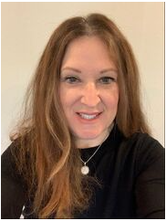
Employee Spotlight: Anne, Scheduling Manager
What do you do at WSky?
Anne: I am the scheduler here at WSky. I schedule intakes for therapists, check insurance, and send out Welcome Emails.
How long have you worked here, and how have things changed in that time?
Anne: I have been with WSky for 2 years. In that time we have hired many new therapists who are eager to help our increased amount of intakes.
What is your favorite aspect of your work?
Anne: My favorite aspect of my work as a scheduler is being able to talk to people and get them the help they need.
What were you doing before working at WSky?
Anne: Before working at WSky, I was a stay at home mom for a long period of time and then was able to get my taste of the insurance business.
How do you like to spend your spare time?
Anne: I like to spend my spare time with family, especially my three sons and dog Lola. I also like to workout and walk, go to my local coffee shop to meet up with friends, and go shopping.
What's one thing you can't live without?
Anne: One thing I cannot live without is my night time self-care routine which includes facial masks, creams, and serums.
What do you do at WSky?
Anne: I am the scheduler here at WSky. I schedule intakes for therapists, check insurance, and send out Welcome Emails.
How long have you worked here, and how have things changed in that time?
Anne: I have been with WSky for 2 years. In that time we have hired many new therapists who are eager to help our increased amount of intakes.
What is your favorite aspect of your work?
Anne: My favorite aspect of my work as a scheduler is being able to talk to people and get them the help they need.
What were you doing before working at WSky?
Anne: Before working at WSky, I was a stay at home mom for a long period of time and then was able to get my taste of the insurance business.
How do you like to spend your spare time?
Anne: I like to spend my spare time with family, especially my three sons and dog Lola. I also like to workout and walk, go to my local coffee shop to meet up with friends, and go shopping.
What's one thing you can't live without?
Anne: One thing I cannot live without is my night time self-care routine which includes facial masks, creams, and serums.

Back to School: Imposter Phenomenon
Albert Einstein once said, “The exaggerated esteem in which my lifework is held makes me very ill at ease. I feel compelled to think of myself as an involuntary swindler.” Einstein isn't alone. In fact, most people experience similar feelings from time to time. Imposter Phenomenon (IP), also called Imposter Syndrome, is the feeling of having fooled others into overrating one's abilities. They doubt their own abilities despite their achievements, and they attribute their accomplishments to luck, networking, or lowered standards rather than their own intelligence and hard work. Experiencing IP can contribute to diminished confidence, excess worry over mistakes, and feelings of shame and lack of belonging. It can prevent people from taking risks or exploring new opportunities, too.
Many learners are returning to school this month, and Imposter Phenomenon is especially common amongst students. Online learning during the pandemic may also have exacerbated these issues for many. Managing the feelings associated with IP can be important for success in the classroom and overall mental wellbeing.
Here are some ways to challenge Imposter Phenomenon: speak kindly to yourself and shift the language of your self-talk. For example, try to reframe the thought "I'm not smart enough" to "I am learning and figuring things out." Reflect on your past experiences and accomplishments, focusing on your strengths, efforts, and achievements. Acknowledge how far you have come, and reward yourself for progress and hard work. Additionally, talk about it with someone you trust because Imposter Phenomenon is very common. (Your personal heroes likely experience it, too!), You will find that you're not alone, and feeling a part of a community can help.
Imposter Phenomenon affects everyone, and these tips will work for non-students, too. Remember, no matter who you are or what you do, you are worthy of good things.
Albert Einstein once said, “The exaggerated esteem in which my lifework is held makes me very ill at ease. I feel compelled to think of myself as an involuntary swindler.” Einstein isn't alone. In fact, most people experience similar feelings from time to time. Imposter Phenomenon (IP), also called Imposter Syndrome, is the feeling of having fooled others into overrating one's abilities. They doubt their own abilities despite their achievements, and they attribute their accomplishments to luck, networking, or lowered standards rather than their own intelligence and hard work. Experiencing IP can contribute to diminished confidence, excess worry over mistakes, and feelings of shame and lack of belonging. It can prevent people from taking risks or exploring new opportunities, too.
Many learners are returning to school this month, and Imposter Phenomenon is especially common amongst students. Online learning during the pandemic may also have exacerbated these issues for many. Managing the feelings associated with IP can be important for success in the classroom and overall mental wellbeing.
Here are some ways to challenge Imposter Phenomenon: speak kindly to yourself and shift the language of your self-talk. For example, try to reframe the thought "I'm not smart enough" to "I am learning and figuring things out." Reflect on your past experiences and accomplishments, focusing on your strengths, efforts, and achievements. Acknowledge how far you have come, and reward yourself for progress and hard work. Additionally, talk about it with someone you trust because Imposter Phenomenon is very common. (Your personal heroes likely experience it, too!), You will find that you're not alone, and feeling a part of a community can help.
Imposter Phenomenon affects everyone, and these tips will work for non-students, too. Remember, no matter who you are or what you do, you are worthy of good things.

Mental Wellness Tips when the Weather Changes
The Pacific Northwest is known for its rainy weather. After the hot summer, the change of season can affect your mood. During the fall and winter, many people feel more sluggish, apathetic, and sad than usual. Fortunately, there are ways you can fight the winter blues and take care of your mental health as we head into the fall and winter seasons.
Stay Active
Although it's tempting to curl up in a blanket on the couch 24/7, even a few minutes of physical activity can boost your mood. Moving your body in gentle ways, such as stretching at your desk, taking the stairs instead of the elevator, or casually strolling your neighborhood, can make a big difference. If you want to get your heartrate up but prefer to stay warm and dry inside, sign up for an indoor exercise class or follow an online workout at home. Set yourself a goal, whether that's running a few miles, getting a certain number of steps, or practicing yoga for 20 minutes. Find what works for you!
Head Outside
Zip up your rain jacket, grab an umbrella, and get some fresh air! Even when the clouds are grey, spending time outdoors can brighten your mood. If you can, get outside during daylight hours everyday. If work or other obstacles prevent you from going outdoors before the sun sets, try to sit near a window or use a light box.
Keep a Sleep Routine
Getting enough sleep is essential for our physical and mental wellbeing. However, the change in daylight hours can throw off our body's internal clock, affecting our natural sleep cycle and mood. Try to keep a healthy sleep routine by going to bed and waking up at the same time. Also avoid bright lights and screens in the hours before bed.
Stay Connected
Social connections are important for our mental health, so try to connect with someone everyday. Call a family member, send a care package, or ask a friend to go for a walk. Social media can be another great way to stay connected, but be mindful of how using social media makes you feel, and limit screen time to a healthy amount for you. Additionally, doing something kind for others, like making a meal for a neighbor or volunteering for a cause you care about, can also help us to feel more connected. And finally, talk to someone you trust about how you're feeling. Your therapist is a great resource to lean on if you are struggling with mood changes this season, too.
The Pacific Northwest is known for its rainy weather. After the hot summer, the change of season can affect your mood. During the fall and winter, many people feel more sluggish, apathetic, and sad than usual. Fortunately, there are ways you can fight the winter blues and take care of your mental health as we head into the fall and winter seasons.
Stay Active
Although it's tempting to curl up in a blanket on the couch 24/7, even a few minutes of physical activity can boost your mood. Moving your body in gentle ways, such as stretching at your desk, taking the stairs instead of the elevator, or casually strolling your neighborhood, can make a big difference. If you want to get your heartrate up but prefer to stay warm and dry inside, sign up for an indoor exercise class or follow an online workout at home. Set yourself a goal, whether that's running a few miles, getting a certain number of steps, or practicing yoga for 20 minutes. Find what works for you!
Head Outside
Zip up your rain jacket, grab an umbrella, and get some fresh air! Even when the clouds are grey, spending time outdoors can brighten your mood. If you can, get outside during daylight hours everyday. If work or other obstacles prevent you from going outdoors before the sun sets, try to sit near a window or use a light box.
Keep a Sleep Routine
Getting enough sleep is essential for our physical and mental wellbeing. However, the change in daylight hours can throw off our body's internal clock, affecting our natural sleep cycle and mood. Try to keep a healthy sleep routine by going to bed and waking up at the same time. Also avoid bright lights and screens in the hours before bed.
Stay Connected
Social connections are important for our mental health, so try to connect with someone everyday. Call a family member, send a care package, or ask a friend to go for a walk. Social media can be another great way to stay connected, but be mindful of how using social media makes you feel, and limit screen time to a healthy amount for you. Additionally, doing something kind for others, like making a meal for a neighbor or volunteering for a cause you care about, can also help us to feel more connected. And finally, talk to someone you trust about how you're feeling. Your therapist is a great resource to lean on if you are struggling with mood changes this season, too.
Story: "The Fence"
There once was a little boy who had a bad temper. His father gave him a bag of nails and told him that every time he lost his temper, he must hammer a nail into the back of the fence. The first day the boy had driven 37 nails into the fence. Over the next few weeks, as he learned to control his anger, the number of nails hammered daily gradually dwindled down. He discovered it was easier to hold his temper than to drive those nails into the fence.
Finally the day came when the boy didn’t lose his temper at all. He told his father about it and the father suggested that the boy now pull out one nail for each day that he was able to hold his temper. The days passed and the young boy was finally able to tell his father that all the nails were gone.
The father took his son by the hand and led him to the fence. He said, “You have done well, my son, but look at the holes in the fence. The fence will never be the same. When you say things in anger, they leave a scar just like this one. You can put a knife in a man and draw it out. It won’t matter how many times you say I’m sorry, the wound is still there.”
A verbal wound is as bad as a physical one. Friends are a very rare jewel, indeed. They make you smile and encourage you to succeed. They lend an ear, they share a word of praise, and they always want to open their hearts to us.
There once was a little boy who had a bad temper. His father gave him a bag of nails and told him that every time he lost his temper, he must hammer a nail into the back of the fence. The first day the boy had driven 37 nails into the fence. Over the next few weeks, as he learned to control his anger, the number of nails hammered daily gradually dwindled down. He discovered it was easier to hold his temper than to drive those nails into the fence.
Finally the day came when the boy didn’t lose his temper at all. He told his father about it and the father suggested that the boy now pull out one nail for each day that he was able to hold his temper. The days passed and the young boy was finally able to tell his father that all the nails were gone.
The father took his son by the hand and led him to the fence. He said, “You have done well, my son, but look at the holes in the fence. The fence will never be the same. When you say things in anger, they leave a scar just like this one. You can put a knife in a man and draw it out. It won’t matter how many times you say I’m sorry, the wound is still there.”
A verbal wound is as bad as a physical one. Friends are a very rare jewel, indeed. They make you smile and encourage you to succeed. They lend an ear, they share a word of praise, and they always want to open their hearts to us.
Summer News, July 2022
In this Issue...
- We Shine a Spotlight on Amber, LCSW
- We Get to Know WSky Business Administrator Melanie
- We Speak the Five Languages of Love
- We Get Curious About our Mental Health
- We Shine a Spotlight on Amber, LCSW
- We Get to Know WSky Business Administrator Melanie
- We Speak the Five Languages of Love
- We Get Curious About our Mental Health

Employee Spotlight: Amber, LCSW
Q. What are you enjoying most about your job at the moment?
Amber: I just really like helping people! I'm excited to create safe spaces for people to be vulnerable and express whatever fear or guilt or shame they might be experiencing, and just to be a person who can be there for them when they haven't had that before from professionals. I enjoy watching my clients make steps to healing from their traumas and celebrate all victories, whether that's just getting out of bed that day or using a coping skill when they are struggling to cope.
Q. What is the focus of your work?
Amber: My niche has been in trauma therapy and understanding how trauma impacts attachments, relationships, safety in the world, our physical responses, and even diagnoses. I also really find it fulfilling to work with teens and young adults. I've found people at those ages often feel misunderstood and overlooked, like they have no voice, and helping them see that their voice is important and that they matter is rewarding. Teens are super fun to work with, too, because they're very honest and open to trying new things and making changes if you give them the space to do that. It's such a difficult age because there are so many changes occurring, and they deserve to have a space to be themselves without judgement or criticism, where they can ask questions and talk about hard things.
I'm also very passionate about creating safe spaces for anyone who has felt marginalized or othered elsewhere in the world because of gender, race, ethnicity, disability, or any other factor. I really enjoy working with LGBTQIA+ population and identify myself as bisexual. I know that folks from this population struggle at times to find safe spaces and have been mistreated in professional settings where you would expect it to be safe, and I take that very seriously. My therapy space will always be a safe space for them and a place of refuge. I will continue to advocate for their needs to be met outside of that space, and I offer my clients gender-affirming letters.
Q. What life experiences prepared you for your work as a therapist?
Amber: I have experienced my own childhood and adult traumas, and I definitely feel like that prepared me for this work because I can deeply relate to those who have gone through similar things. I took on a role of being a listener and a caretaker at a young age, and I have this ability to form connections with people and help them feel seen. I'm one of those people that strangers come up to and start sharing their stories with because I tend to have a calming presence. I have been told that my energy is very grounding for those around me, and I am truly an empathetic person that digs in with my clients and their feelings. I can hold that space for them, so they know they are not alone. That is something I needed growing up, and it is something that I will continue to give back.
Q. How do you stay grounded when working with people who've experienced trauma?
Amber: I continue to do my own work and my own therapy, so I have space to hold other people's traumas and hurts. I take the time to make sure that I am really doing my best with each client, and this gives me comfort, just knowing that I did everything I could do in that moment to be there for that person.
Q. What brings you joy outside of work?
Amber: During the pandemic I got really into plants! Now I have humidifiers and grow lights - it's ridiculous! It's so interesting to watch them grow and get new leaves, or get better if they've been sick. I talk to them and nurture them, tell them that they're doing a great job. I can take a healthy plant and make new babies from it, give them away, and know that they'll keep making new babies... spread the love!
Q. What are you enjoying most about your job at the moment?
Amber: I just really like helping people! I'm excited to create safe spaces for people to be vulnerable and express whatever fear or guilt or shame they might be experiencing, and just to be a person who can be there for them when they haven't had that before from professionals. I enjoy watching my clients make steps to healing from their traumas and celebrate all victories, whether that's just getting out of bed that day or using a coping skill when they are struggling to cope.
Q. What is the focus of your work?
Amber: My niche has been in trauma therapy and understanding how trauma impacts attachments, relationships, safety in the world, our physical responses, and even diagnoses. I also really find it fulfilling to work with teens and young adults. I've found people at those ages often feel misunderstood and overlooked, like they have no voice, and helping them see that their voice is important and that they matter is rewarding. Teens are super fun to work with, too, because they're very honest and open to trying new things and making changes if you give them the space to do that. It's such a difficult age because there are so many changes occurring, and they deserve to have a space to be themselves without judgement or criticism, where they can ask questions and talk about hard things.
I'm also very passionate about creating safe spaces for anyone who has felt marginalized or othered elsewhere in the world because of gender, race, ethnicity, disability, or any other factor. I really enjoy working with LGBTQIA+ population and identify myself as bisexual. I know that folks from this population struggle at times to find safe spaces and have been mistreated in professional settings where you would expect it to be safe, and I take that very seriously. My therapy space will always be a safe space for them and a place of refuge. I will continue to advocate for their needs to be met outside of that space, and I offer my clients gender-affirming letters.
Q. What life experiences prepared you for your work as a therapist?
Amber: I have experienced my own childhood and adult traumas, and I definitely feel like that prepared me for this work because I can deeply relate to those who have gone through similar things. I took on a role of being a listener and a caretaker at a young age, and I have this ability to form connections with people and help them feel seen. I'm one of those people that strangers come up to and start sharing their stories with because I tend to have a calming presence. I have been told that my energy is very grounding for those around me, and I am truly an empathetic person that digs in with my clients and their feelings. I can hold that space for them, so they know they are not alone. That is something I needed growing up, and it is something that I will continue to give back.
Q. How do you stay grounded when working with people who've experienced trauma?
Amber: I continue to do my own work and my own therapy, so I have space to hold other people's traumas and hurts. I take the time to make sure that I am really doing my best with each client, and this gives me comfort, just knowing that I did everything I could do in that moment to be there for that person.
Q. What brings you joy outside of work?
Amber: During the pandemic I got really into plants! Now I have humidifiers and grow lights - it's ridiculous! It's so interesting to watch them grow and get new leaves, or get better if they've been sick. I talk to them and nurture them, tell them that they're doing a great job. I can take a healthy plant and make new babies from it, give them away, and know that they'll keep making new babies... spread the love!

Employee Spotlight: Melanie, Business Administrator
What is your role at WSky?
Melanie: As administrator/biller, I oversee the financial aspect of WSky, from collecting copays to posting insurance payments, and I help with the recruiting process.
What do you like best about your job?
Melanie: Everyone is very friendly and eager to help. Also, all of the clients are always very appreciative of any assistance that I can provide.
What 3 words would you use to describe WSky?
Melanie: Kind, compassionate, supportive
Since moving here a year-and-a-half ago, what has been your favorite thing about living in Eugene?
Melanie: The highlight is living next door to my best friend of 49 years, but I also love the variety of things to do in Eugene, such as concerts, restaurants, theater, outdoor markets, cycling, etc. There's so much to do!
What does self-care look like for you?
Melanie: A long run, taking a bath, hiking while enjoying the flora and fauna, gardening. I tend to try to channel my focus to things I enjoy.
If you could be any animal, what would you be and why?
Melanie: If I could be any animal, I would be a dolphin. Dolphins are social, innovative, and playful, like me!
What is your role at WSky?
Melanie: As administrator/biller, I oversee the financial aspect of WSky, from collecting copays to posting insurance payments, and I help with the recruiting process.
What do you like best about your job?
Melanie: Everyone is very friendly and eager to help. Also, all of the clients are always very appreciative of any assistance that I can provide.
What 3 words would you use to describe WSky?
Melanie: Kind, compassionate, supportive
Since moving here a year-and-a-half ago, what has been your favorite thing about living in Eugene?
Melanie: The highlight is living next door to my best friend of 49 years, but I also love the variety of things to do in Eugene, such as concerts, restaurants, theater, outdoor markets, cycling, etc. There's so much to do!
What does self-care look like for you?
Melanie: A long run, taking a bath, hiking while enjoying the flora and fauna, gardening. I tend to try to channel my focus to things I enjoy.
If you could be any animal, what would you be and why?
Melanie: If I could be any animal, I would be a dolphin. Dolphins are social, innovative, and playful, like me!
Speak the Language of Love
You probably already know that learning a new language has many benefits, but what if we told you there is a language that could help you strengthen your relationships?
The term "love language" came from the research of Dr. Gary Chapman over 25 years ago. Based on this research, he suggested that every person gives and receives love differently. Understanding the way you and the people in your life express and accept love may help you to identify your feelings, understand one another better, and communicate better.
Chapman defined five love languages:
How can I incorporate my love language into my life?
You probably already know that learning a new language has many benefits, but what if we told you there is a language that could help you strengthen your relationships?
The term "love language" came from the research of Dr. Gary Chapman over 25 years ago. Based on this research, he suggested that every person gives and receives love differently. Understanding the way you and the people in your life express and accept love may help you to identify your feelings, understand one another better, and communicate better.
Chapman defined five love languages:
- Quality Time - You thrive on togetherness, time, attention, and conversation.
- Words of Affirmation - You need to hear that you are important, loved, and valued.
- Receiving Gifts - You are touched by the thought and effort that go into choosing a gift. (This doesn't mean you are materialistic. The perfect gift could be a homemade baked good or a handwritten card.)
- Acts of Service - You feel supported by people's helping actions. To you, acts of service, such as doing the dishes or cooking a meal, speak louder than words.
- Physical Touch - You feel cared for through holding, kissing, warm hugs, or a light touch.
How can I incorporate my love language into my life?
- Identify your love language. Think about when you have felt the most loved, valued, or appreciated. What made you feel that way? You can also take the 5 Love Languages Quiz to help you understand your love language.
- Tell your loved one how you feel using "I" statements. "I" statements are assertive and clear communications to help your partner understand your feelings and needs. They also help to avoid coming off as accusatory or demanding. Try "I feel (emotion) when (situation happens)."
- Tell them what you need. Next, tell your partner what you need with clarity and simplicity, such as "I need a hug to feel loved."
- Ask your partner what they need. To help your partner feel your love for them, consider their needs and implement their love language into your words and actions. You could even take the Love Languages quiz together and discuss your results!

How Curiosity Benefits our Mental Health
The old adage goes, "Curiosity killed the cat." But, in fact, curiosity is linked to improved mental, social, and physical health. And you might be curious to know why!
First of all, from an evolutionary perspective, curiosity helps us survive. When stimulated by new experiences, your brain releases dopamine to make you feel good and keep you engaged, alert, and attentive to novelty in your environment.
Moreover, research has linked curiosity to happiness. Todd Kashdan, a George Mason University psychology professor and author, explains, “If you take the fundamental things that people tend to want out of life — strong social relationships and happiness and accomplishing things — all of these are highly linked to curiosity." Additionally, people tend to display more curiosity on days when they feel happier, indicating that the relationship between curiosity and positive emotions may be bidirectional. For this reason, improving your mental health overall may help you become more curious, and in return, increased curiosity might help you manage and improve your mood.
Curiosity can also help with managing symptoms of anxiety by releasing the feel-good neurotransmitter dopamine. When we anticipate learning and feel curious, our brain releases dopamine in anticipation of a reward. It's this mindset of curiosity that invites wonder that can stop your anxious brain from thinking of every "worse-case scenario" which creates anxiety and drives fear.
Curiosity also drives empathy, which is an important part of social interactions and healthy relationships. Recall a time when someone felt engaged and steadfastly focused on you and what you had to say. How did that make you feel? What was your response? You probably felt pretty good and closer to that person. When we're truly curious about people, we're more dedicated to understanding their perspective and life experience. We become more empathetic towards others. Additionally, when people demonstrate genuine curiosity, they're often perceived as open and warm. In these ways, curiosity builds closeness.
How can we improve our curiosity? To begin, embrace uncertainty. Rather than becoming frustrated, be curious about the unknown or unknowable. Try to think about things in a new way.
The old adage goes, "Curiosity killed the cat." But, in fact, curiosity is linked to improved mental, social, and physical health. And you might be curious to know why!
First of all, from an evolutionary perspective, curiosity helps us survive. When stimulated by new experiences, your brain releases dopamine to make you feel good and keep you engaged, alert, and attentive to novelty in your environment.
Moreover, research has linked curiosity to happiness. Todd Kashdan, a George Mason University psychology professor and author, explains, “If you take the fundamental things that people tend to want out of life — strong social relationships and happiness and accomplishing things — all of these are highly linked to curiosity." Additionally, people tend to display more curiosity on days when they feel happier, indicating that the relationship between curiosity and positive emotions may be bidirectional. For this reason, improving your mental health overall may help you become more curious, and in return, increased curiosity might help you manage and improve your mood.
Curiosity can also help with managing symptoms of anxiety by releasing the feel-good neurotransmitter dopamine. When we anticipate learning and feel curious, our brain releases dopamine in anticipation of a reward. It's this mindset of curiosity that invites wonder that can stop your anxious brain from thinking of every "worse-case scenario" which creates anxiety and drives fear.
Curiosity also drives empathy, which is an important part of social interactions and healthy relationships. Recall a time when someone felt engaged and steadfastly focused on you and what you had to say. How did that make you feel? What was your response? You probably felt pretty good and closer to that person. When we're truly curious about people, we're more dedicated to understanding their perspective and life experience. We become more empathetic towards others. Additionally, when people demonstrate genuine curiosity, they're often perceived as open and warm. In these ways, curiosity builds closeness.
How can we improve our curiosity? To begin, embrace uncertainty. Rather than becoming frustrated, be curious about the unknown or unknowable. Try to think about things in a new way.
- Ask, how does this work? Why does...? What if...?
- Make mindful observations throughout the day, and look for wonder in little things. For example, go for a walk in your neighborhood, and try to notice things you haven't paid attention to before.
- Focus on the journey, not the destination. In other words, be curious about the possibilities instead of problem-solving.
- Notice when you're being judgmental, jumping to conclusions, or making assumptions. Instead, replace anger with empathy by trying to be more open-minded.
Spring News, April 2022
In this Issue...
- We Spotlight Jenny T., One of WSky's Awesome Therapists
- We Practice the Art of Distraction in Times of Turbulence
- We Use Our Head, Follow Our Heart, and Trust Our Gut
- We Spotlight Jenny T., One of WSky's Awesome Therapists
- We Practice the Art of Distraction in Times of Turbulence
- We Use Our Head, Follow Our Heart, and Trust Our Gut
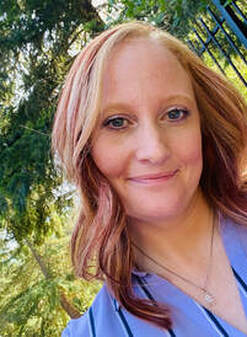
Employee Spotlight: Jenny T., LMFT
Q. What are you enjoying most about your job at the moment?
Jenny: My favorite thing is the variety of people I get to meet from different backgrounds, different walks of life, and that I not only get to help someone through their story, but I also get to learn so much about people along the way. I use the word "resilience" carefully, but in this instance, it really makes sense to say that I get to see how resilient people really are, and that is just amazing.
Q. Other than your professional training, what parts of your life most prepared you to work as a therapist?
Jenny: I come from a big family - one of ten siblings! That definitely prepared me to navigate a lot of different perspectives and understand both the rewards and challenges of that. I also moved around a lot growing up and got to experience different people and communities. I was always curious, wondering why people do what they do.
I have a real love for working with people experiencing a variety of traumas, including veterans and veteran families impacted by PTSD, because a lot of people I love have been impacted in those ways. Growing up low-income gave me insight into what it takes to work through the impacts and traumas related to having a lower socioeconomic status. Lots of things I did kind of pushed against gender norms while I was growing up and gave me a sense of what it's like to push through that, how hard it is, and at the same time, totally worth it.
Q. How would you describe your current therapy practice? What is your approach to working with clients?
Jenny: I bring a trauma lens to my work that's informed by research I did as an undergraduate student into the impacts of childhood abuse on physical and mental health, including memory. I think about the many ways trauma impacts people and the multiple places that trauma can come from - family of origin, culture, the systems a person is involved with.
I also bring an understanding of systems to my work, and how people are impacted by the many that they belong to, including family, of course, but also systems like the communities they belong to or the workplace.
I help people assess where they're at with all aspects of themselves, body, mind, and spirit, notice those areas they've been injured, and build coping skills so at the end they feel more whole - their emotional cup feels more full. I really enjoy helping people get back to who they know themselves to be or who they desire to be.
Q. Is there anything about your life outside of being a therapist that might surprise people?
Jenny: I'm a drummer, and a lot of people are surprised by that. I started drumming rhythms on pots and pans when I was probably about two, but then got into it more seriously in high school. I've been in a few bands, but since becoming a parent, it's become a hobby now - something I just do for myself. When I have the time, I can just sit down and lose myself for a couple of hours rocking out!
Q. What are you enjoying most about your job at the moment?
Jenny: My favorite thing is the variety of people I get to meet from different backgrounds, different walks of life, and that I not only get to help someone through their story, but I also get to learn so much about people along the way. I use the word "resilience" carefully, but in this instance, it really makes sense to say that I get to see how resilient people really are, and that is just amazing.
Q. Other than your professional training, what parts of your life most prepared you to work as a therapist?
Jenny: I come from a big family - one of ten siblings! That definitely prepared me to navigate a lot of different perspectives and understand both the rewards and challenges of that. I also moved around a lot growing up and got to experience different people and communities. I was always curious, wondering why people do what they do.
I have a real love for working with people experiencing a variety of traumas, including veterans and veteran families impacted by PTSD, because a lot of people I love have been impacted in those ways. Growing up low-income gave me insight into what it takes to work through the impacts and traumas related to having a lower socioeconomic status. Lots of things I did kind of pushed against gender norms while I was growing up and gave me a sense of what it's like to push through that, how hard it is, and at the same time, totally worth it.
Q. How would you describe your current therapy practice? What is your approach to working with clients?
Jenny: I bring a trauma lens to my work that's informed by research I did as an undergraduate student into the impacts of childhood abuse on physical and mental health, including memory. I think about the many ways trauma impacts people and the multiple places that trauma can come from - family of origin, culture, the systems a person is involved with.
I also bring an understanding of systems to my work, and how people are impacted by the many that they belong to, including family, of course, but also systems like the communities they belong to or the workplace.
I help people assess where they're at with all aspects of themselves, body, mind, and spirit, notice those areas they've been injured, and build coping skills so at the end they feel more whole - their emotional cup feels more full. I really enjoy helping people get back to who they know themselves to be or who they desire to be.
Q. Is there anything about your life outside of being a therapist that might surprise people?
Jenny: I'm a drummer, and a lot of people are surprised by that. I started drumming rhythms on pots and pans when I was probably about two, but then got into it more seriously in high school. I've been in a few bands, but since becoming a parent, it's become a hobby now - something I just do for myself. When I have the time, I can just sit down and lose myself for a couple of hours rocking out!

The Art of Distraction in Times of Turbulence
If you are feeling an onslaught of intense emotions lately, you are not alone. With everything happening in the world around us, it's not surprising that we'd feel a range of emotions, including irritability, frustration, sadness, grief, anger, or even rage. Although there are no “bad” emotions and each serves a purpose, some emotions can be distressing and challenging to experience. They can impact our entire sense of wellbeing. Sometimes meeting our emotions calls for compassion and attention, as well as attunement to our sensations, thoughts, and feelings. At other times we may need a distraction, a mini vacation from these emotions that allows us to return to the matter later.
Distraction is a valuable skill, and it isn't avoidance - it's a temporary means of taking care of yourself away from an intense situation so that you can eventually step back into it with fresh eyes and a clear mind.
In dialectical behavior therapy (DBT), distress tolerance refers to a set of skills for coping with intense and uncomfortable emotions. One such skill is represented by the acronym “ACCEPTS.” Using ACCEPTS can help you manage emotions until you are able to address a situation, and it offers you seven ways to deal with overwhelming emotions in the moment.
A: Activities: Engage in an activity that requires your energy and attention.
Organize your cupboard or desk space. Practice a hobby, like dancing, running or sewing.
C. Contributing: Focus on something outside yourself.
Help a friend with moving, work on school project with your child, or volunteer in your community.
C. Comparisons: Try to compare your current emotions to a time when things were worse.
Identify a time you felt more distress than you do right now and remind yourself that you weathered the storm. Or remind yourself of a time when you were happier, and remind yourself that you will feel better again.
E. Emotions: Engage in activities that induce the opposite emotion you are currently feeling.
If you feel sad, watch a funny movie. If you feel overwhelmed, try practicing calming yoga.
P. Pushing Away: Put the negative thoughts out of your mind until a better time.
Imagine writing your thoughts on a piece of paper and crumbling it up and throwing it away, or writing your thoughts in the sand and letting the waves wash them away.
T. Thoughts: Focus on your thoughts if your emotions are too overwhelming.
Count to 100, follow a guided meditation, or reread your favorite book.
S. Sensations: Focus on a safe physical sensation to distract you from negative emotions.
Eat a sour candy and focus on the taste, hold a cold ice cube in your hand and focus on the sensation, or sit on a swing set and feel the wind on your face.
If you are feeling an onslaught of intense emotions lately, you are not alone. With everything happening in the world around us, it's not surprising that we'd feel a range of emotions, including irritability, frustration, sadness, grief, anger, or even rage. Although there are no “bad” emotions and each serves a purpose, some emotions can be distressing and challenging to experience. They can impact our entire sense of wellbeing. Sometimes meeting our emotions calls for compassion and attention, as well as attunement to our sensations, thoughts, and feelings. At other times we may need a distraction, a mini vacation from these emotions that allows us to return to the matter later.
Distraction is a valuable skill, and it isn't avoidance - it's a temporary means of taking care of yourself away from an intense situation so that you can eventually step back into it with fresh eyes and a clear mind.
In dialectical behavior therapy (DBT), distress tolerance refers to a set of skills for coping with intense and uncomfortable emotions. One such skill is represented by the acronym “ACCEPTS.” Using ACCEPTS can help you manage emotions until you are able to address a situation, and it offers you seven ways to deal with overwhelming emotions in the moment.
A: Activities: Engage in an activity that requires your energy and attention.
Organize your cupboard or desk space. Practice a hobby, like dancing, running or sewing.
C. Contributing: Focus on something outside yourself.
Help a friend with moving, work on school project with your child, or volunteer in your community.
C. Comparisons: Try to compare your current emotions to a time when things were worse.
Identify a time you felt more distress than you do right now and remind yourself that you weathered the storm. Or remind yourself of a time when you were happier, and remind yourself that you will feel better again.
E. Emotions: Engage in activities that induce the opposite emotion you are currently feeling.
If you feel sad, watch a funny movie. If you feel overwhelmed, try practicing calming yoga.
P. Pushing Away: Put the negative thoughts out of your mind until a better time.
Imagine writing your thoughts on a piece of paper and crumbling it up and throwing it away, or writing your thoughts in the sand and letting the waves wash them away.
T. Thoughts: Focus on your thoughts if your emotions are too overwhelming.
Count to 100, follow a guided meditation, or reread your favorite book.
S. Sensations: Focus on a safe physical sensation to distract you from negative emotions.
Eat a sour candy and focus on the taste, hold a cold ice cube in your hand and focus on the sensation, or sit on a swing set and feel the wind on your face.
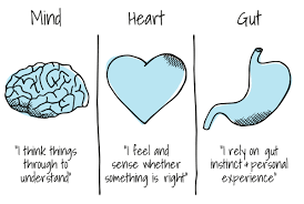
Three Brains are Better than One: Balancing the Head, Heart, & Gut
Have you ever worked on a team to brainstorm a group project or solve a complex problem? More often than not, putting your heads together improves the team's work and leads to a better finished product. So, wouldn't it be great if you had your own team of multiple brains to help you make decisions and solve problems? Well, neuroscientific research has found that you actually have three brains: the head, the heart, and the gut.
The three brains communicate through sophisticated systems made up of billions of neurons. Like your brain, your heart and gut can process information, sense, learn, communicate, remember, and change. Interestingly, the heart and the gut send more messages to the brain than the brain sends messages to them. Your heart and your gut have a lot to say, and they are worth listening to.
As you go about your day, your three brains converse subconsciously. But by paying attention to all three brains, you can develop deeper insight and self-awareness, which can help with decision making. Neuroscientists call this multiple brain integration, or mBIT. With the combined wisdom of your head, heart, and gut, you can make more intuitive decisions, bring balance to your life, and improve your mental and physical wellbeing.
To help you access each of your three brains, try this journaling exercise. Reflect on the questions below.
Use Your Head: How often do I rely on my head to make decisions? When has "using my head" helped me to make a good decision? When has it had negative consequences on my life? What enjoyable actions would help me feel more engaged with my head center?
Follow Your Heart: How often do I rely on my heart when making decisions? When has "following my heart" helped me to make a good decision? When has it had negative consequences on my life? What enjoyable actions would help me feel more engaged with my heart center?
Trust Your Gut: How often do I rely on my gut when making decisions? When has "trusting my gut" helped me to make a good decision? When has it had negative consequences on my life? What enjoyable actions would help me feel more engaged with my gut center?
A three legged stool: Imagine the three brains as a three legged stool. Does the stool feel steady or wobbly? Which leg of the stool am I trying to balance on right now? How can I use the other two legs to ground myself and create balance? Which brain am I using the most right now, and which brain requires more effort to engage?
Have you ever worked on a team to brainstorm a group project or solve a complex problem? More often than not, putting your heads together improves the team's work and leads to a better finished product. So, wouldn't it be great if you had your own team of multiple brains to help you make decisions and solve problems? Well, neuroscientific research has found that you actually have three brains: the head, the heart, and the gut.
The three brains communicate through sophisticated systems made up of billions of neurons. Like your brain, your heart and gut can process information, sense, learn, communicate, remember, and change. Interestingly, the heart and the gut send more messages to the brain than the brain sends messages to them. Your heart and your gut have a lot to say, and they are worth listening to.
As you go about your day, your three brains converse subconsciously. But by paying attention to all three brains, you can develop deeper insight and self-awareness, which can help with decision making. Neuroscientists call this multiple brain integration, or mBIT. With the combined wisdom of your head, heart, and gut, you can make more intuitive decisions, bring balance to your life, and improve your mental and physical wellbeing.
To help you access each of your three brains, try this journaling exercise. Reflect on the questions below.
Use Your Head: How often do I rely on my head to make decisions? When has "using my head" helped me to make a good decision? When has it had negative consequences on my life? What enjoyable actions would help me feel more engaged with my head center?
Follow Your Heart: How often do I rely on my heart when making decisions? When has "following my heart" helped me to make a good decision? When has it had negative consequences on my life? What enjoyable actions would help me feel more engaged with my heart center?
Trust Your Gut: How often do I rely on my gut when making decisions? When has "trusting my gut" helped me to make a good decision? When has it had negative consequences on my life? What enjoyable actions would help me feel more engaged with my gut center?
A three legged stool: Imagine the three brains as a three legged stool. Does the stool feel steady or wobbly? Which leg of the stool am I trying to balance on right now? How can I use the other two legs to ground myself and create balance? Which brain am I using the most right now, and which brain requires more effort to engage?
Winter News, February 2022
In this Issue...
- We Celebrate Black American Health and Wellness
- We Spotlight the Connection between Eating Disorders and Seasonal Depression
- We Reduce the Stigma around Bipolar Disorder
- We Celebrate Black American Health and Wellness
- We Spotlight the Connection between Eating Disorders and Seasonal Depression
- We Reduce the Stigma around Bipolar Disorder

Black History Month: Honoring Black American Health and Wellness
In 1976, President Gerald Ford officially recognized Black History Month and challenged Americans to “seize the opportunity to honor the too-often neglected accomplishments of Black Americans in every area of endeavor throughout our history.”
Forty years later, Barack Obama, the nation's first Black president, delivered a message of his own from the White House where he recognized past champions of justice, honored the contributions of African Americans since our country's beginning, and recommitted to reaching for a day when no person is judged by anything but the content of their character.
Every February, the U.S. continues to honor the contributions and sacrifices of African Americans with a theme. This year's theme, Black Health and Wellness is particularly significant as we all continue to face the challenges of the COVID pandemic. This year, WSky shares Black American pioneers, medical experts, holistic leaders, and resources we hope you find informative.
12 Black American Health and Wellness Pioneers
Black Leaders in Holistic Wellness
Celebrating 10 African American Medical Pioneers
Black Mental Health Alliance
Black-Owned Business in Oregon
44 Mental Health Resources for Black People Trying to Survive in This Country, by Zahra Barnes
The BIPOC Project
Social media: Therapy While Black, Black Mental Health Alliance, Black on Black Therapy
In 1976, President Gerald Ford officially recognized Black History Month and challenged Americans to “seize the opportunity to honor the too-often neglected accomplishments of Black Americans in every area of endeavor throughout our history.”
Forty years later, Barack Obama, the nation's first Black president, delivered a message of his own from the White House where he recognized past champions of justice, honored the contributions of African Americans since our country's beginning, and recommitted to reaching for a day when no person is judged by anything but the content of their character.
Every February, the U.S. continues to honor the contributions and sacrifices of African Americans with a theme. This year's theme, Black Health and Wellness is particularly significant as we all continue to face the challenges of the COVID pandemic. This year, WSky shares Black American pioneers, medical experts, holistic leaders, and resources we hope you find informative.
12 Black American Health and Wellness Pioneers
Black Leaders in Holistic Wellness
Celebrating 10 African American Medical Pioneers
Black Mental Health Alliance
Black-Owned Business in Oregon
44 Mental Health Resources for Black People Trying to Survive in This Country, by Zahra Barnes
The BIPOC Project
Social media: Therapy While Black, Black Mental Health Alliance, Black on Black Therapy

Spotlight on Eating Disorders & Seasonal Depression
National Eating Disorder Awareness Week is February 21st-27th. This campaign aims to educate the public and provide visibility and understanding for individuals and families affected by eating disorders. But, did you know that mood disorders, like depression and seasonal affective disorder (SAD) commonly co-occur with eating disorders?
According to the National Association of Anorexia Nervosa and Associated Disorders (ANAD), 28.8 million Americans will struggle with an eating disorder during their lifetime. Despite common misconception, less than 6% of people with eating disorders are underweight. Eating disorders come in all shapes and sizes, and they be can't recognized by appearance alone. Anorexia Nervosa is perhaps the most well-known, but other diagnosable eating disorders include Bulimia Nervosa, Binge Eating Disorder, Avoidant/Restrictive Food Intake Disorder (AFRID), and Other Specified Feeding and Eating Disorders (OSFED).
Notably, mood disorders, like depression, commonly co-occur with eating disorders. In a study of women with eating disorders and co-occurring diagnoses, NEDA found that 94% of participants with an eating disorder also experienced a mood disorder. One mood disorder, Seasonal Affective Disorder (SAD) refers to depression that occurs during the same time every year. Winter's lack of sunlight and cold weather can contribute to symptoms like fatigue, hopelessness, and social withdrawal. A craving for carbs and desire to comfort eat is also common. SAD may exacerbate eating disorder behaviors, and vice versa. In fact, many individuals struggling with eating disorders experience increased severity of their symptoms during the cold, rainy months.
Fortunately, eating disorders recovery is possible, and seasonal depression is treatable. For those who struggle with both an eating disorder and SAD, recognizing how the two interact can help you address and manage your symptoms. You can also support National Eating Disorder Awareness Week by educating yourself and sharing what you learn with others, offering support to a friend or loved one who is struggling with their eating behaviors, and by prioritizing your mental health, engaging in healthy behaviors and mental health habits, and encouraging others to do so, too.
When the sky is dark and you are indoors this winter, there are a number of things you can try to help take care of your mental health.
And of course, talk to your therapist or someone you trust about how you are feeling.
National Eating Disorder Awareness Week is February 21st-27th. This campaign aims to educate the public and provide visibility and understanding for individuals and families affected by eating disorders. But, did you know that mood disorders, like depression and seasonal affective disorder (SAD) commonly co-occur with eating disorders?
According to the National Association of Anorexia Nervosa and Associated Disorders (ANAD), 28.8 million Americans will struggle with an eating disorder during their lifetime. Despite common misconception, less than 6% of people with eating disorders are underweight. Eating disorders come in all shapes and sizes, and they be can't recognized by appearance alone. Anorexia Nervosa is perhaps the most well-known, but other diagnosable eating disorders include Bulimia Nervosa, Binge Eating Disorder, Avoidant/Restrictive Food Intake Disorder (AFRID), and Other Specified Feeding and Eating Disorders (OSFED).
Notably, mood disorders, like depression, commonly co-occur with eating disorders. In a study of women with eating disorders and co-occurring diagnoses, NEDA found that 94% of participants with an eating disorder also experienced a mood disorder. One mood disorder, Seasonal Affective Disorder (SAD) refers to depression that occurs during the same time every year. Winter's lack of sunlight and cold weather can contribute to symptoms like fatigue, hopelessness, and social withdrawal. A craving for carbs and desire to comfort eat is also common. SAD may exacerbate eating disorder behaviors, and vice versa. In fact, many individuals struggling with eating disorders experience increased severity of their symptoms during the cold, rainy months.
Fortunately, eating disorders recovery is possible, and seasonal depression is treatable. For those who struggle with both an eating disorder and SAD, recognizing how the two interact can help you address and manage your symptoms. You can also support National Eating Disorder Awareness Week by educating yourself and sharing what you learn with others, offering support to a friend or loved one who is struggling with their eating behaviors, and by prioritizing your mental health, engaging in healthy behaviors and mental health habits, and encouraging others to do so, too.
When the sky is dark and you are indoors this winter, there are a number of things you can try to help take care of your mental health.
- Light therapy can help improve symptoms of depression.
- Indoor activities you enjoy, like, reading, making art, journaling, meditation, watching movies, or playing video games can relieve stress.
- Follow a gentle yoga video on YouTube, explore an online dance class and get some movement while staying inside.
- Grab your headphones, and listen to ASMR to help you relax and fall asleep.
- Listen to podcasts about mental health, or watch licensed professional therapists on YouTube and TikTok to learn more about mental health.
And of course, talk to your therapist or someone you trust about how you are feeling.
Reduce Stigma on World Bipolar Day: March 30, 2022
On March 30th each year, the world comes together to raise awareness of Bipolar disorder, a mental health disorder that affects nearly 7 million Americans. World Bipolar Day is observed on the birthday of Dutch painter Vincent van Gogh who was was posthumously diagnosed with bipolar disorder.
Bipolar disorder is a brain disorder that causes changes in a person's mood and can impact one's health, relationships, work, and ability to manage every day tasks. According to the American Psychiatric Association, people with bipolar disorder experience intense emotional states that typically occur during distinct periods of days to weeks, called mood episodes. These mood episodes are categorized as manic/hypomanic (abnormally happy or irritable mood) or depressive (sad mood). People with bipolar disorder also have periods of neutral mood as well.
The goal of World Bipolar Day is to bring awareness to bipolar disorders and to eliminate social stigma. Here are just a few things to know to reduce stigma and support people with Bipolar disorder.
On March 30th each year, the world comes together to raise awareness of Bipolar disorder, a mental health disorder that affects nearly 7 million Americans. World Bipolar Day is observed on the birthday of Dutch painter Vincent van Gogh who was was posthumously diagnosed with bipolar disorder.
Bipolar disorder is a brain disorder that causes changes in a person's mood and can impact one's health, relationships, work, and ability to manage every day tasks. According to the American Psychiatric Association, people with bipolar disorder experience intense emotional states that typically occur during distinct periods of days to weeks, called mood episodes. These mood episodes are categorized as manic/hypomanic (abnormally happy or irritable mood) or depressive (sad mood). People with bipolar disorder also have periods of neutral mood as well.
The goal of World Bipolar Day is to bring awareness to bipolar disorders and to eliminate social stigma. Here are just a few things to know to reduce stigma and support people with Bipolar disorder.
- Bipolar disorder affects every aspect of life: It may be difficult to fully comprehend the toll bipolar disorder can take on someone because it is an invisible illness.
- Bipolar disorder has many causes, from genetics to life events: A study from the University of Michigan that spanned nearly two decades found that there is no single genetic change, life event, or chemical brain imbalance that could be the root cause of bipolar disorder.
- Everyone’s bipolar disorder is different: No two people have the exact same symptoms and experience. Each diagnosis can vary greatly. However, there are two main types of bipolar: Bipolar I which is characterized by one or more manic episodes that last at least a week and require hospitalization; and bipolar II, which is characterized by more depressive episodes.
- Treatment. Treatment can provide relief by identifying what's wrong and reducing symptoms that interfere with work and personal life. Typically, treatment involves a combination of at least one mood-stabilizing drug and/or atypical antipsychotic, plus therapy.
- Stigma doesn't just come from others. People with Bipolar may mistakenly believe that the condition is a sign of personal weakness or that they should be able to control it without help. Seeking counseling, education about the condition, medication and connecting with others who have mental illness can help people with Bipolar to gain self-esteem and overcome destructive self-judgment.
Autumn News, September 2021
In this Issue...
- We Return to School
- We Discuss Suicide Prevention and Awareness
- We Engage in our Community
- We Create for Self Care
- We Return to School
- We Discuss Suicide Prevention and Awareness
- We Engage in our Community
- We Create for Self Care
Back to School
The days are growing cooler, the sun is setting earlier, the trees are shedding their leaves, and the school bells are ringing.
The beginning of the academic year can stir up different emotions. Some folks might be feeling excited about their new classes and seeing friends again after a long summer. For others, however, this may be a time of heightened stress as they anticipate the busy days and heavy workloads ahead. Parents may be struggling with letting go as their child becomes more independent, whether they are starting kindergarten or college. For those who have lost a child or a loved one, the start of school may be a painful reminder of the student who is no longer here. Additionally, debate around masks and Covid-19 regulations may be causing additional worry that is unique from previous years. A mix of all of these emotions might come up, too.
It is okay to feel whatever you are feeling right now. Reflecting what you're experiencing, ask yourself, "What do I need right now?" You can start to identify coping strategies and finding ways to keep taking care of yourself this season. Maybe its prioritizing sleep, taking breaks, talking it out, journaling, petting your furry friend, or going outside.
The days are growing cooler, the sun is setting earlier, the trees are shedding their leaves, and the school bells are ringing.
The beginning of the academic year can stir up different emotions. Some folks might be feeling excited about their new classes and seeing friends again after a long summer. For others, however, this may be a time of heightened stress as they anticipate the busy days and heavy workloads ahead. Parents may be struggling with letting go as their child becomes more independent, whether they are starting kindergarten or college. For those who have lost a child or a loved one, the start of school may be a painful reminder of the student who is no longer here. Additionally, debate around masks and Covid-19 regulations may be causing additional worry that is unique from previous years. A mix of all of these emotions might come up, too.
It is okay to feel whatever you are feeling right now. Reflecting what you're experiencing, ask yourself, "What do I need right now?" You can start to identify coping strategies and finding ways to keep taking care of yourself this season. Maybe its prioritizing sleep, taking breaks, talking it out, journaling, petting your furry friend, or going outside.

National Suicide Prevention and Awareness Month
September is National Suicide Prevention and Awareness Month. According to the American Foundation for Suicide Prevention (AFSP), suicide is the 10th leading cause of death in the United States. In Oregon, suicide is the 8th leading cause of death overall, and the 2nd leading cause of death for people between the ages of 10 and 44. In 2019, 12 million Americans had thoughts of suicide, and 1.4 million attempted suicide.
Considering these concerning statistics, most people are affected by suicide in some way. However, because suicide can be difficult to talk about, people often feel isolated in this experience. If you have lost someone to suicide, experienced a personal struggle, or know someone who has, you are not alone. By raising awareness about suicide, we can end the stigma surrounding it and help ourselves and the people we care about.
90% of people who die by suicide have an underlying, treatable mental health condition. Research by AFSP has shown that specific treatments in counseling, like Cognitive Behavioral Therapy (CBT) and Dialectical Behavior Therapy (DBT), are effective at helping people manage their behaviors and thoughts related to suicide. Certain medications can also help reduce suicidal thoughts and behaviors, too. Notably, after getting through intense moments of active crisis, most people will not die by suicide. Most (85-95%) of suicide attempt survivors continue go on to engage in life. If you or someone you know is struggling, please seek support.
Everyone can play a part in suicide prevention. If you are worried someone is considering suicide, you don't have to be a professional to help. Starting a conversation can help someone who is struggling to find connection, support, and hope.
How to have a conversation about suicide: In a safe private setting, tell them why you are concerned, and ask them about suicide directly and non-judgmentally: "Are you thinking about ending your life?" Asking won't put the idea in their head. Instead, it will provide an opportunity for them to talk about what they are experiencing. Listen without judgement, let them know you care, and ask how you can best support them. In an emergency situation, do not leave them alone, and call 911. Also always refer the person who is struggling to additional resources, like crisis hotlines and counseling services. (See our list of national and community resources below.) After having the conversation, be sure to check in with them again later.
Remember: you don't have to be an expert, and you don't have to know all the answers. Make an observation, ask the question, show you care, link them to additional support, and follow up with them after the conversation. And of course, take care of yourself.
Suicide Prevention Resources for our Community:
September is National Suicide Prevention and Awareness Month. According to the American Foundation for Suicide Prevention (AFSP), suicide is the 10th leading cause of death in the United States. In Oregon, suicide is the 8th leading cause of death overall, and the 2nd leading cause of death for people between the ages of 10 and 44. In 2019, 12 million Americans had thoughts of suicide, and 1.4 million attempted suicide.
Considering these concerning statistics, most people are affected by suicide in some way. However, because suicide can be difficult to talk about, people often feel isolated in this experience. If you have lost someone to suicide, experienced a personal struggle, or know someone who has, you are not alone. By raising awareness about suicide, we can end the stigma surrounding it and help ourselves and the people we care about.
90% of people who die by suicide have an underlying, treatable mental health condition. Research by AFSP has shown that specific treatments in counseling, like Cognitive Behavioral Therapy (CBT) and Dialectical Behavior Therapy (DBT), are effective at helping people manage their behaviors and thoughts related to suicide. Certain medications can also help reduce suicidal thoughts and behaviors, too. Notably, after getting through intense moments of active crisis, most people will not die by suicide. Most (85-95%) of suicide attempt survivors continue go on to engage in life. If you or someone you know is struggling, please seek support.
Everyone can play a part in suicide prevention. If you are worried someone is considering suicide, you don't have to be a professional to help. Starting a conversation can help someone who is struggling to find connection, support, and hope.
How to have a conversation about suicide: In a safe private setting, tell them why you are concerned, and ask them about suicide directly and non-judgmentally: "Are you thinking about ending your life?" Asking won't put the idea in their head. Instead, it will provide an opportunity for them to talk about what they are experiencing. Listen without judgement, let them know you care, and ask how you can best support them. In an emergency situation, do not leave them alone, and call 911. Also always refer the person who is struggling to additional resources, like crisis hotlines and counseling services. (See our list of national and community resources below.) After having the conversation, be sure to check in with them again later.
Remember: you don't have to be an expert, and you don't have to know all the answers. Make an observation, ask the question, show you care, link them to additional support, and follow up with them after the conversation. And of course, take care of yourself.
Suicide Prevention Resources for our Community:
- Suicide Prevention Hotline: 1-800-273-8255, hearing impaired: 1-800-799-4889, for Spanish: 1-888-628-9454
- Crisis Text Line: text HOME to 741741
- Oregon Warmline (can call just to talk): 1-800-698-2392
- Veterans Crisis Line: 1-800-273-8255 (press 1), text to 838255, hearing impaired 1-800-799-4889
- Trans Lifeline: 1-877-565-8860
- Trevor Lifeline: 1-866-488-7386, text START to 678678, or live chat through their website
- Crisis (White Bird) Assistance for Lane County: 541-687-4000 or 1-800-422-7558
- University of Oregon Counseling Center (for UO students): 541-346-3227 (office phone number and after-hours support line)
- CAHOOTS (White Bird): Routed through non-emergency police dispatch. Eugene: 541-682-5111, Springfield: 541-726-3714
- Jasper Mountain Crisis Response Program: can be accessed by youth or family member: 1-888-989-9990
- Hourglass Community Crisis Center: 541-505-8426
- Looking Glass Youth & Family Crisis: up to 18 yrs. old or parent: 541-689-3111
- Shelter Care: shelter resources: 541-686-1262, behavioral health services: 541-505-5188, temporary rent assistance: 541-689-3785
- Hope & Safety Alliance (Womenspace): 541-485-6513, 1-800-281-2800, or Webchat
- American Foundation for Suicide Prevention
- American Foundation for Suicide Prevention - Oregon Chapter
- Be the One To (Learn more about taking action to prevent suicide).

Active Autumn: Ideas for Community Connection
There are so many wonderful things about fall: warm beverages, soft sweaters, colorful trees, Halloween decorations, pumpkin spice everything! Most of these are best enjoyed when shared, but it can also be difficult to stay active and engaged in the community this time of year.
For that reason, we have compiled a list of activities and events that may help you feel connected with the Eugene community. Of course, make sure to follow Covid-19 guidelines, wear masks, social distance, and stay safe!
Local Events:
There are so many wonderful things about fall: warm beverages, soft sweaters, colorful trees, Halloween decorations, pumpkin spice everything! Most of these are best enjoyed when shared, but it can also be difficult to stay active and engaged in the community this time of year.
For that reason, we have compiled a list of activities and events that may help you feel connected with the Eugene community. Of course, make sure to follow Covid-19 guidelines, wear masks, social distance, and stay safe!
Local Events:
- Eugene Saturday Market - Farmer's Market & Crafts Market (Saturdays 10am-4pm, downtown Eugene)
- Out of the Darkness Walk - Suicide Prevention and Awareness Virtual Community Walk (Sep. 26 10:30am-12:30pm)
- Turkey Trot - Thanksgiving Day 5K (Nov. 25, 9am, Alton Baker Park)
- Movember - No Shave November, Men's Health Month (month of November)
- Grilled Cheese Experience - Eat yummy sandwiches and support Food for Lane County (month of February)
- Go "foliage watching" - Walk around your neighborhood or local park and notice the colorful foliage. Take a picture or make a sketch. Observe changes each week.
- Carve pumpkins - Visit a local farm or pick up a pumpkin from the grocery store, and have a pumpkin carving party at home.
- Social Distancing Friendsgiving - Start a new tradition by hosting a virtual "Friendsgiving" and share a festive meal with friends who are far away.

Art for Self-Care
When words aren't enough, engaging in the creative process can open up alternative forms of communication. Dance, music, drama, and visual art can be healing. With the guidance of a professional art therapist, art therapy can be an effective treatment for many populations and a wide variety of concerns. Engaging in art activities at home can also provide accessible opportunities to self-reflect and explore avenues of expression! The kinesthetic, emotional, and cognitive experiences of art-making foster self-awareness, self-esteem, insight, emotional resilience, and mindfulness.
Everyone is an artist. If you haven't picked up a paintbrush since elementary school, don't worry! Challenge yourself to try this art therapy activity at home. Try to refrain from self-judgement and focus on the process. You can't do it wrong!
Transformational Self-Portraits
Autumn reminds us that life is a series of changes. With this activity you can reflect on how you have changed over time. Using any materials you prefer (paint, colored pencils, pens, collage, etc.) create three self portraits: one of your past, present, and future self.
1) PAST: For the first portrait, reflect on a past experience that had a negative or positive impact on you. How did you feel when this event happened? How did it change you?
2) PRESENT: Next, reflect on who you are now as a result of that experience. Who are you now? What is important to you? What do you like about yourself? Consider what you might prefer to change about your present self or how would you like to grow?
3) FUTURE: Finally, consider who you want to become. Are you experiencing any "problems" within yourself that you would like to address? Maybe you ruminate on a past experience, feel angry more often than you would like, or feel distracted when spending time with your family. What would your ideal self look like? What do you value? What do you hope your life will look like in the future?
Once you're finished, lay out your three portraits next to each other, and reflect on how it felt to create them. You could even try journaling or talking about it with someone you trust, like your partner or therapist. Give yourself credit for taking time out of your busy day to engage in this project and focus on yourself.
When words aren't enough, engaging in the creative process can open up alternative forms of communication. Dance, music, drama, and visual art can be healing. With the guidance of a professional art therapist, art therapy can be an effective treatment for many populations and a wide variety of concerns. Engaging in art activities at home can also provide accessible opportunities to self-reflect and explore avenues of expression! The kinesthetic, emotional, and cognitive experiences of art-making foster self-awareness, self-esteem, insight, emotional resilience, and mindfulness.
Everyone is an artist. If you haven't picked up a paintbrush since elementary school, don't worry! Challenge yourself to try this art therapy activity at home. Try to refrain from self-judgement and focus on the process. You can't do it wrong!
Transformational Self-Portraits
Autumn reminds us that life is a series of changes. With this activity you can reflect on how you have changed over time. Using any materials you prefer (paint, colored pencils, pens, collage, etc.) create three self portraits: one of your past, present, and future self.
1) PAST: For the first portrait, reflect on a past experience that had a negative or positive impact on you. How did you feel when this event happened? How did it change you?
2) PRESENT: Next, reflect on who you are now as a result of that experience. Who are you now? What is important to you? What do you like about yourself? Consider what you might prefer to change about your present self or how would you like to grow?
3) FUTURE: Finally, consider who you want to become. Are you experiencing any "problems" within yourself that you would like to address? Maybe you ruminate on a past experience, feel angry more often than you would like, or feel distracted when spending time with your family. What would your ideal self look like? What do you value? What do you hope your life will look like in the future?
Once you're finished, lay out your three portraits next to each other, and reflect on how it felt to create them. You could even try journaling or talking about it with someone you trust, like your partner or therapist. Give yourself credit for taking time out of your busy day to engage in this project and focus on yourself.
Summer News, August 2021
In this Issue...
- We Return to Community after Social Distancing
- We Encourage Body Acceptance
- We Feel the Benefits of Sunshine
- We Journal for Self Care
- We Return to Community after Social Distancing
- We Encourage Body Acceptance
- We Feel the Benefits of Sunshine
- We Journal for Self Care
Social Anxiety after Social Distancing

As vaccination rates increase, businesses and restaurants re-open, families and friends reconnect, and the world begins to look more like it did a couple of years ago, we are finding the pandemic has transformed the way we live and learn. After more than a year of social distancing and acclimating to numerous changes including virtual learning, online socializing and home-based work, it's understandable that society reopening may lead to an increase in social anxiety.
It's normal to feel nervous in some social situations. With social anxiety, everyday interactions cause significant distress, self-consciousness and embarrassment. It can even impact the way you think about yourself, your opportunities, others, the world, the future, the past, the present, and the meaning of your life.
While feeling fearful of new situations, experiencing anxious thoughts about interacting with others, or worry about embarrassing yourself in public might be a new experience for many, for those who struggled with social anxiety before the pandemic, you might feel better understood. Whether this is a new or old feeling, re-integration and increased social interaction will be an adjustment for everyone.
Here are some tips to help you manage social anxiety while returning to a more social life:
It's normal to feel nervous in some social situations. With social anxiety, everyday interactions cause significant distress, self-consciousness and embarrassment. It can even impact the way you think about yourself, your opportunities, others, the world, the future, the past, the present, and the meaning of your life.
While feeling fearful of new situations, experiencing anxious thoughts about interacting with others, or worry about embarrassing yourself in public might be a new experience for many, for those who struggled with social anxiety before the pandemic, you might feel better understood. Whether this is a new or old feeling, re-integration and increased social interaction will be an adjustment for everyone.
Here are some tips to help you manage social anxiety while returning to a more social life:
- Take it slow. Gradually reintroduce new activities. Start with what feels easiest first and work your way up.
- Set priorities in your life. You can reduce anxiety by carefully managing your time and energy with people and activities you enjoy.
- Reach out to friends you've lost touch with over the last year. The fear of rejection might make you hesitant, but chances are, they'll be happy to hear from you. It feels great when a friend checks in and asks for a life update. Even so, simply making the effort is often more important than what you say.
- Evaluate your friendships. Time for friends is always in limited supply, and if spending time with someone isn't good for your mental wellbeing, it's okay to break up with a friend.
- Set boundaries for what you are comfortable with. Everyone's boundaries will be different. If you want to avoid physical contact, it's okay to keep physical distance, say no to hugs, and continue to wear a mask.
- Practice self-care and relaxation techniques.
- Talk about your concerns with a friend or someone you trust. Seek out therapy when you need it. You're not alone.
Every Body is a Beach Body: Tips for Body Acceptance this Summer
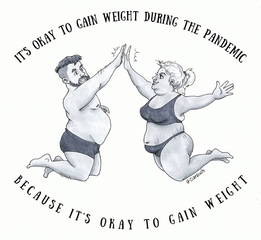
It's okay not to love our bodies all of the time. Body acceptance, or body neutrality, is about accepting our bodies as they are right now, even if we still have insecurities.
Because of the unrealistic beauty standards that proliferate our society and the sky-high pressure to have the perfect summer body, accepting our bodies this Summer could be even more challenging. During the height of the pandemic, we all spent more time indoors and at home where many people experienced loneliness, stress, anxiety, depression and boredom. As a result many of us gained weight. However, weight gain is natural response to such unprecedented stress and nothing to be ashamed of.
Whatever perceived imperfections might get you down about your body, you can practice body acceptance:
Because of the unrealistic beauty standards that proliferate our society and the sky-high pressure to have the perfect summer body, accepting our bodies this Summer could be even more challenging. During the height of the pandemic, we all spent more time indoors and at home where many people experienced loneliness, stress, anxiety, depression and boredom. As a result many of us gained weight. However, weight gain is natural response to such unprecedented stress and nothing to be ashamed of.
Whatever perceived imperfections might get you down about your body, you can practice body acceptance:
- Stop negative self-talk in its tracks, and replace it with positive affirmations. If you wouldn't say it to a friend, don't say it to yourself. This might be challenging at first, but keep practicing! Believing your self affirmations can take time and repetition.
- Unfollow social media accounts that promote diet culture and unrealistic beauty standards.
- If you are returning to an exercise routine for the first time in a while, be patient with yourself. You might not be as strong/fast/flexible/etc. as when you left off, but believe in yourself and enjoy the process of doing something good for your body.
- Wear clothing that fits and feels comfortable. Acknowledge that it is okay to change sizes.
- Appreciate what your body does for you more than how it looks.
- Identify 3 things you love about your body. It could be anything, even your elbow, freckles, or scars.
Here Comes the Sun: Mental Health Benefits of Sunshine

Oregonians don't see the sun for many months each year, so the summer sunshine is usually a welcome reprieve from the grey, wet winter. (As the Beatles say, "Here comes the sun. It feels like years since it's been here.") Research shows that sunlight can benefit our mental health in a number of ways.
Sunlight has been linked to serotonin, a chemical many antidepressants boost, and Vitamin D. Studies have found that on cloudy days serotonin levels tend to be lower, contributing to decreased mood, depression, and anxiety. However, on sunny days serotonin levels are higher, leading to greater feelings of calmness, focus, and satisfaction. Low levels of Vitamin D have also been linked to depression, and Vitamin D deficiency can cause lower levels of serotonin, which helps regulate our mood and sleep cycle. Exposure to sunlight, which our skin converts to Vitamin D, can help reduce symptoms of depression in those who are Vitamin D deficient.
Sunlight exposure can help regulate your sleep cycle by letting your body know what time it is. Darkness triggers your body to produce the hormone melatonin, which makes you sleepy. Getting sunlight exposure during the day and limiting screen time at night can help you get a better night's rest.
Seasonal Affective Disorder (SAD) refers to depressive episodes corresponding to changes in the seasons. Although people can experience SAD during the summer, it most often occurs during the winter. During the winter, days are shorter, the sky is cloudier, and the cold rain may keep people inside. Changes in weather may lead to changes in mood, increased lethargy, and hopelessness. Less sun exposure is believed to contribute to occurrences of SAD. Getting sunlight when you can and using light box for a few minutes each day when the skies are clouded over may help people with SAD boost their mood.
In addition to SAD, research has shown that rates of eating disorder occurrences also rise during the winter. This suggests that Vitamin D, melatonin, and serotonin may play a role in the increase of disordered eating behaviors. Spending more time outdoors and exposure to sunlight can help people struggling with eating disorders to lift their mood and manage symptoms.
Fortunately, you can receive the benefits of sunlight with as little as 5 to 15 minutes of exposure. If you are going to be outside in the sun for longer, you should wear sunscreen to protect your skin, and make sure to stay hydrated when it is hot.
Sunlight has been linked to serotonin, a chemical many antidepressants boost, and Vitamin D. Studies have found that on cloudy days serotonin levels tend to be lower, contributing to decreased mood, depression, and anxiety. However, on sunny days serotonin levels are higher, leading to greater feelings of calmness, focus, and satisfaction. Low levels of Vitamin D have also been linked to depression, and Vitamin D deficiency can cause lower levels of serotonin, which helps regulate our mood and sleep cycle. Exposure to sunlight, which our skin converts to Vitamin D, can help reduce symptoms of depression in those who are Vitamin D deficient.
Sunlight exposure can help regulate your sleep cycle by letting your body know what time it is. Darkness triggers your body to produce the hormone melatonin, which makes you sleepy. Getting sunlight exposure during the day and limiting screen time at night can help you get a better night's rest.
Seasonal Affective Disorder (SAD) refers to depressive episodes corresponding to changes in the seasons. Although people can experience SAD during the summer, it most often occurs during the winter. During the winter, days are shorter, the sky is cloudier, and the cold rain may keep people inside. Changes in weather may lead to changes in mood, increased lethargy, and hopelessness. Less sun exposure is believed to contribute to occurrences of SAD. Getting sunlight when you can and using light box for a few minutes each day when the skies are clouded over may help people with SAD boost their mood.
In addition to SAD, research has shown that rates of eating disorder occurrences also rise during the winter. This suggests that Vitamin D, melatonin, and serotonin may play a role in the increase of disordered eating behaviors. Spending more time outdoors and exposure to sunlight can help people struggling with eating disorders to lift their mood and manage symptoms.
Fortunately, you can receive the benefits of sunlight with as little as 5 to 15 minutes of exposure. If you are going to be outside in the sun for longer, you should wear sunscreen to protect your skin, and make sure to stay hydrated when it is hot.
Journaling for Self Care

Writing regularly in a journal can be a simple, accessible tool for self-care. Journaling provides us an opportunity to sit with our emotions and release them, reframe our thoughts, identify patterns, and prioritize self-care and our mental health. You can work with whatever materials you have available, like a composition book or printer paper, and take just 5 minutes out of the day to develop a journaling habit. Be honest with yourself - no one else will be reading your journal - and be kind to yourself. You can write about anything you want, but if you are feeling stuck, here are some prompts to help get you started:
- Write one paragraph about what made you happy today.
- What self-care activity have you always been curious about trying?
- What do you wish others knew about you?
- What do you need right now?
Spring News, May 2021
In This Issue
- We Raise Awareness for Mental Health Month
- We Redirect Negative Thoughts
- We Quiet The Mind
- We Explore Self-Expression Through Creative Writing
Raise Awareness
Each year millions of Americans face the reality of living with a mental illness. During May, we join the national movement to raise awareness about mental health and promote a positive approach to mental health and well being. This a time for making choices and taking inspired action to fight stigma, provide support, educate ourselves and advocate for policies that support people with mental illness, and their families.
If you are interested in tools or activities to get involved and improve mental health, Mental Health America offers education, tools, screenings, podcasts, blogs, policy and more. You may also consider the following podcasts for support and sharing:
If you are interested in tools or activities to get involved and improve mental health, Mental Health America offers education, tools, screenings, podcasts, blogs, policy and more. You may also consider the following podcasts for support and sharing:
Redirect Negative Thoughts
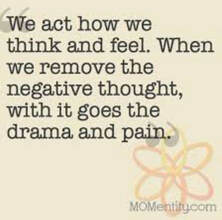
Many people experience negative thoughts for one reason or another. We beat ourselves up for our slightest failing, get stuck in a loop of worry, talk ourselves out of sensible risks, or get wrapped in a blanket of shame. It is, however, when this negative noise becomes constant and pervasive that people find this behavior to be particularly detrimental to their mental health and wellbeing. Some people find the following techniques can help them to redirect those negative thoughts into a more productive image of oneself.
- Remind yourself what you like about yourself. Come up with a list of things that you like about yourself, be them big or small. If you feel like it would be helpful or fun, keep it in a journal. Continue to add onto your list as you think about it over the next days, weeks and months. Even if your initial list is short, as time goes on it will continue to grow and grow.
- Seek out positive thoughts. It can be as simple as picking out a few things from your day that you liked, even if they were small, or even a few objects you like around your house.
- Create positive reframes. Try replacing thoughts like, ‘I can’t do this,’ or ‘I’m not good enough,’ with ‘I am trying my best,’ or ‘I will give it my all.’ Think about the times you use the word "never" or "always" and ask yourself if that's really true? Or, if it's more like "sometimes" that's true.
- Avoid thought stopping. Thought stopping is the process in which a person sits down and tries to identify negative thoughts so that they can nip them in the bud. The problem with this is that it often leads to dwelling on those negative thoughts about oneself. Instead focus on what is positive rather than stopping the negative.
Quiet The Mind

When caught in a cycle of anxious thoughts and feelings sometimes it can be helpful to practice quieting your mind to lift fears and worries. Quieting your mind does not mean stopping to think at all, it means reducing the chatter in your head. When you can quiet your mind, your ability to focus improves, you can think more clearly, and your awareness expands.
The act of quieting the mind and relaxing your thoughts can take different forms depending on what you are looking for, what you are comfortable with, and what your worldview is.
For some people, meditation is a tried-and-true practice for quieting fear-based thoughts, but there are other methods that are equally effective. For some people quieting the mind looks like relaxed breathing with slow, deep, rhythmic breaths. Others practice progressive muscle relaxation, a practice where you work your way through your own body by focusing mentally and physically on different limbs, tensing your muscles to the rhythm of your breaths before moving on to another part of their body. Other options to quiet the mind might include mindfulness assisted with guided imagery, where videos can be readily found online. Other individuals who perhaps find different religious practices to be beneficial to their mental and spiritual health may practice prayer.
This only goes to show how people can practice different methods with different meanings to them and find similar benefits when it comes to quieting the mind. It can be useful to try multiple techniques and perhaps give one your own personal flair to see what works best for you.
Regardless of which practice is right for you, look for a quiet place without too many distractions, perhaps a quiet room or in nature if that is your preference.
The act of quieting the mind and relaxing your thoughts can take different forms depending on what you are looking for, what you are comfortable with, and what your worldview is.
For some people, meditation is a tried-and-true practice for quieting fear-based thoughts, but there are other methods that are equally effective. For some people quieting the mind looks like relaxed breathing with slow, deep, rhythmic breaths. Others practice progressive muscle relaxation, a practice where you work your way through your own body by focusing mentally and physically on different limbs, tensing your muscles to the rhythm of your breaths before moving on to another part of their body. Other options to quiet the mind might include mindfulness assisted with guided imagery, where videos can be readily found online. Other individuals who perhaps find different religious practices to be beneficial to their mental and spiritual health may practice prayer.
This only goes to show how people can practice different methods with different meanings to them and find similar benefits when it comes to quieting the mind. It can be useful to try multiple techniques and perhaps give one your own personal flair to see what works best for you.
Regardless of which practice is right for you, look for a quiet place without too many distractions, perhaps a quiet room or in nature if that is your preference.
Explore Creative Writing
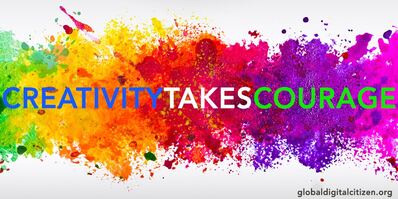
Express Yourself With Creative Writing Creative writing offers a unique opportunity to foster self-expression, build confidence, clarify thoughts, and bolster empathy and communication skills. Research published in January 2018 in Advances in Psychiatric Treatment linked this type of writing to improved emotional and mental health.
You don’t have to be a pro to give it a try — just get out a notebook or open up a Word document and explore the following prompts:
1. Write a letter to yourself highlighting your strengths - snail mail it to yourself.
2. Imagine how you would introduce yourself to a stranger, now write that same introduction from the perspective of your closest friend.
3. When I'm in physical or emotional pain, the kindest words I can offer myself are...
You don’t have to be a pro to give it a try — just get out a notebook or open up a Word document and explore the following prompts:
1. Write a letter to yourself highlighting your strengths - snail mail it to yourself.
2. Imagine how you would introduce yourself to a stranger, now write that same introduction from the perspective of your closest friend.
3. When I'm in physical or emotional pain, the kindest words I can offer myself are...
Winter News, Jan. 2021
In This Issue
- We Celebrate Black History
- We Acknowledge Loneliness
- We Honor Self-Compassion
- We Encourage Mindfulness
Celebrate Black History
Throughout history and to this day, Black men and women from around the world have made extraordinary contributions to our societies. This month we shared in our newsletter a few profiles, resources and activities that inspired us:
PBS Black Culture Connection - Inspirational women
PBS Civil Rights Icons
Center for Racial Justice in Education
34 Black History Month Activities for February and Beyond
PBS Black Culture Connection - Inspirational women
PBS Civil Rights Icons
Center for Racial Justice in Education
34 Black History Month Activities for February and Beyond
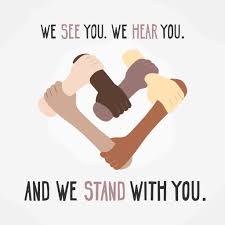
Social Justice Informed Mental Health Literacy (SJM)
Mental health literacy is important across all communities. It is the ability to understand mental health problems and their treatments, decrease stigma and increase help-seeking behaviors that enable us all to obtain and maintain positive mental health. However, with traditional mental health literacy, Black history is left out of the conversation. With histories, and often still current realities, that include racism, oppression, isolation and desolation, barriers including stigma, lack of representation, lack of transportation, healthcare costs, and community beliefs can limit access, participation and equity. These barriers must be acknowledged and addressed in order for real healing to begin.
If you are looking for a way to participate in mental health literacy, here are a few social justice principles that any person can consider:
- Reflect on your own beliefs and experiences. Look at how they were created and
where there is room to grow.
- Practice compassion and empathy.
- Validate the history of harm in Black communities.
- Acknowledge the resilience of past and present Black communities.
- Listen to concerns and advocate for changes to Black mental healthcare.
- Advocate for more accessible mental healthcare for Black communities.
- Get involved in other social justice movements with Black communities
such as police brutality, gentrification, or criminal justice reform to name
a few.
Mental health literacy is important across all communities. It is the ability to understand mental health problems and their treatments, decrease stigma and increase help-seeking behaviors that enable us all to obtain and maintain positive mental health. However, with traditional mental health literacy, Black history is left out of the conversation. With histories, and often still current realities, that include racism, oppression, isolation and desolation, barriers including stigma, lack of representation, lack of transportation, healthcare costs, and community beliefs can limit access, participation and equity. These barriers must be acknowledged and addressed in order for real healing to begin.
If you are looking for a way to participate in mental health literacy, here are a few social justice principles that any person can consider:
- Reflect on your own beliefs and experiences. Look at how they were created and
where there is room to grow.
- Practice compassion and empathy.
- Validate the history of harm in Black communities.
- Acknowledge the resilience of past and present Black communities.
- Listen to concerns and advocate for changes to Black mental healthcare.
- Advocate for more accessible mental healthcare for Black communities.
- Get involved in other social justice movements with Black communities
such as police brutality, gentrification, or criminal justice reform to name
a few.
Acknowledge Loneliness
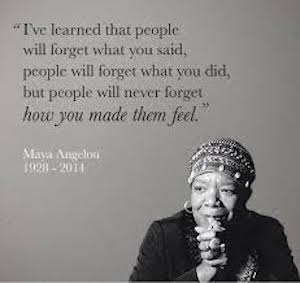
Feeling Lonely This Month? You Are Not Alone.
Feeling melancholy or down around this time of year is common and completely normal. Longer winter months and Valentine's Day "expectations" can lead to risks of social isolation and feeling lonely — whether or not we’re living through a global pandemic.
While there are various ways you can reduce loneliness through connecting with others (and you may be intimately familiar with your gaming console, zoom, text apps, and the good old fashioned cell phone), consider the relationship you have with you. This relationship may be the most important to feeling less alone.
Set aside a period of time each day to check in with yourself. You could meditate, journal, practice yoga, create a gratitude list or host your own dance party. This activity can be done in as little as five minutes, but it’s helpful to do it every day so it becomes a healthy habit.
When it comes to Valentine’s Day, treat it as a day to express gratitude, learn something new, pamper yourself, or maybe all of the above. Order dinner in, plan a walk, snuggle with your kitty, read a book, bake cookies, teach yourself a new skill (knitting?), or take an online class.
Even if you feel lonely, you don't have to be alone in your actions. Studies have shown that acts of gratitude can help us feel more positive and have stronger relationships. Consider buying the person in line behind you at Starbucks a coffee, smile at the grocery store clerk, or reach out to a loved one for a little support. If your feelings of loneliness don’t go away or feel unbearable, or if you are feeling anxious or depressed, contact us at [email protected].
Feeling melancholy or down around this time of year is common and completely normal. Longer winter months and Valentine's Day "expectations" can lead to risks of social isolation and feeling lonely — whether or not we’re living through a global pandemic.
While there are various ways you can reduce loneliness through connecting with others (and you may be intimately familiar with your gaming console, zoom, text apps, and the good old fashioned cell phone), consider the relationship you have with you. This relationship may be the most important to feeling less alone.
Set aside a period of time each day to check in with yourself. You could meditate, journal, practice yoga, create a gratitude list or host your own dance party. This activity can be done in as little as five minutes, but it’s helpful to do it every day so it becomes a healthy habit.
When it comes to Valentine’s Day, treat it as a day to express gratitude, learn something new, pamper yourself, or maybe all of the above. Order dinner in, plan a walk, snuggle with your kitty, read a book, bake cookies, teach yourself a new skill (knitting?), or take an online class.
Even if you feel lonely, you don't have to be alone in your actions. Studies have shown that acts of gratitude can help us feel more positive and have stronger relationships. Consider buying the person in line behind you at Starbucks a coffee, smile at the grocery store clerk, or reach out to a loved one for a little support. If your feelings of loneliness don’t go away or feel unbearable, or if you are feeling anxious or depressed, contact us at [email protected].
Honor Self-Compassion
Love Yourself a little More this Month: A Few Tips for Improving Self-Confidence
February is often consider the month of love, yet we are not always loving or compassionate toward ourselves. Below are a few acts of self-efficacy (trusting your own capacity for judgment, and belief in your own abilities and personal qualities) you can take to improve self-confidence and increase self-love.
February is often consider the month of love, yet we are not always loving or compassionate toward ourselves. Below are a few acts of self-efficacy (trusting your own capacity for judgment, and belief in your own abilities and personal qualities) you can take to improve self-confidence and increase self-love.
- Practice self-compassion. Remember that no human is perfect. Some people hold themselves to higher standards than they do other people, forgetting that they too can and will make mistakes. A part of this is acknowledging your mistakes and failures and remembering your capacity to forgive yourself for them as you do other people's mistakes.
- Limit how often you judge yourself. Regulate how long you either think about your perceived negative traits or even actively put yourself down mentally or verbally. Self improvement can be a wonderful thing, though it can be detrimental to your self-confidence to only focus on your faults instead of prioritizing taking steps to avoid repeating behaviors you do not like.
- Enter a cycle of self-care. Taking risks to improve your situation can come from increased self-confidence. An increased self-confidence can also lead to taking risks to improve your situation. If you are not already in this cycle, take steps to put yourself into it by actively caring for yourself.
Encourage Mindfulness

Scan Your Body for Calm
A body scan is a technique that focuses on different parts of your body, where you move your attention progressively from head to toe (or toe to head) and brings your awareness into your physical sensations. A 2-3 minute body scan can help you:
A body scan is a technique that focuses on different parts of your body, where you move your attention progressively from head to toe (or toe to head) and brings your awareness into your physical sensations. A 2-3 minute body scan can help you:
- Connect your mind and body
- Increase mindfulness and release stress
- Counteract negative feelings
- Notice and release tension
- Identify physical sensations






